Belkin F5D9000B Wireless G Plus MIMO Desktop Card User Manual Belkin
Belkin International, Inc. Wireless G Plus MIMO Desktop Card Belkin
Belkin >
Manual

F5D9000 revised manual
Page 1 of 62
Belkin
Wireless G Plus MIMO Desktop Card
User Manual
F5D9000
Table of Contents
1 Introduction . . . . . . . . . . . . . . . . . . . . . . . . . . . . . . . . . . . . . . . . . . . . X
Benefits of a Home Network . . . . . . . . . . . . . . . . . . . . . . . . . . . . . . X
Advantages of a Wireless Network . . . . . . . . . . . . . . . . . . . . . . . . . X
Placement of your Wireless Networking
Hardware for Optimal Performance . . . . . . . . . . . . . . . . . . . . . . . . X
2 Overview . . . . . . . . . . . . . . . . . . . . . . . . . . . . . . . . . . . . . . . . . . . . . . . X
Product Features . . . . . . . . . . . . . . . . . . . . . . . . . . . . . . . . . . . . . . X
Applications and Advantages . . . . . . . . . . . . . . . . . . . . . . . . . . . . X
Product Specifications . . . . . . . . . . . . . . . . . . . . . . . . . . . . . . . . . . X
System Requirements . . . . . . . . . . . . . . . . . . . . . . . . . . . . . . . . . . X
Package Contents . . . . . . . . . . . . . . . . . . . . . . . . . . . . . . . . . . . . . X
3 Installing and Setting up the Card . . . . . . . . . . . . . . . . . . . . . . . . X
Step 1A: Install. . . . . . . . . . . . . . . . . . . . . . . . . . . . . . X
Step 1B: Insert. . . . . . XX
Step 1C: Configure. . . . . . . . . . . . . . . . . XX
Step 2A: Install. . . . . . . . . . . . . . . . . . . . . . . . . . . . . . X
Step 2B: Insert. . . . . . X
Step 2C: Configure. . . . . . . . . . . . . . . . . XX
4 Using the Belkin Wireless Networking Utility. . . . . . . . . . . . . . . . X
Accessing the Belkin Wireless Networking Utility from the Windows System
Tray.16
Setting Wireless Network Profiles……………… X
Securing your Wi-Fi Network . . . . . . . . . . . . . . . . . . . . . . . . . . . XX
Configuring your Belkin Wireless G Plus MIMO Desktop Card to use
Security. . . . . . . . . . XX
5 Troubleshooting. . . . . . . . . . . . . . . . . . . . . . . . . . . . . . . . . . . . . . . . XX
6 Information . . . . . . . . . . . . . . . . . . . . . . . . . . . . . . . . . . . . . . . . . . . . XX
F5D9000 revised manual
Page 2 of 62
Introduction
Thank you for purchasing the Belkin Wireless G Plus MIMO Desktop Card (the
Card). Now you can take advantage of this great new technology and gain the
freedom to network your home and office computers wirelessly. This Card allows
you to connect a desktop computer to your network. The easy installation and
setup will have you networking wirelessly in minutes. Please be sure to read
through this User Manual completely, and pay special attention to the section
entitled “Placement of your Wireless Networking Hardware for Optimal
Performance” on page 2.
Benefits of a Home Network
Your Belkin Home Network will allow you to:
• Share one high-speed Internet connection with all the computers
in your home
• Share resources, such as files, and hard drives among all the
connected computers in your home
• Share a single printer with the entire family
• Share documents, music, video, and digital pictures
• Store, retrieve, and copy files from one computer to another
• Simultaneously play games online, check Internet email,
and chat
Advantages of a Wireless Network
Here are some of the advantages of setting up a Belkin wireless network:
• Mobility –you’ll no longer need a dedicated “computer room”— now you can
work on a networked laptop or desktop computer anywhere within your wireless
range
• Easy installation – Belkin Easy Installation Wizards make setup simple
• Flexibility – set up and access printers, computers, and other networking
devices from anywhere in your home
• Easy expansion – the wide range of Belkin networking products lets you
expand your network to include devices such as printers and gaming consoles
• No cabling required – you can spare the expense and hassle of retrofitting
Ethernet cabling throughout the home or office
• Widespread industry acceptance – choose from a wide range of
interoperable networking products
F5D9000 revised manual
Page 3 of 62
Placement of your Wireless Networking Hardware for Optimal Performance
Your wireless connection will be stronger the closer your computer is to your
wireless router (or access point). Typical indoor operating range for your wireless
devices is between 100 and 200 feet. In the same way, your wireless connection
and performance will degrade somewhat as the distance between your wireless
router (or access point) and connected devices increases. This may or may not
be noticeable to you. As you move farther from your wireless router (or access
point), connection speed may decrease. Factors that can weaken signals simply
by getting in the way of your network’s radio waves are metal appliances or
obstructions, and walls.
If you have concerns about your network’s performance that might be related to
range or obstruction factors, try moving the computer to a position between five
and 10 feet from the wireless router (or access point) in order to see if distance is
the problem. If difficulties persist even at close range, please contact Belkin
Technical Support.
Note: While some of the items listed below can affect network performance, they
will not prohibit your wireless network from functioning; if you are concerned that
your network is not operating at its maximum effectiveness, this checklist may
help.
1. Placement of your Wireless Router (or Access Point)
Place your wireless router (or access point), the central connection point of your
network, as close as possible to the center of your wireless network devices.
To achieve the best wireless network coverage for your “wireless clients,” (i.e.
computers enabled by Belkin Wireless Notebook Cards, Wireless Desktop Cards,
and Wireless USB Adapters):
• Ensure that your wireless router’s (or access point’s) antennas are parallel to
each other, and are positioned vertically (toward the ceiling). If your wireless
router (or access point) itself is positioned vertically, point the antennas as much
as possible in an upward direction.
• In multistory homes, place the wireless router (or access point) on a floor that is
as close to the center of the home as possible. This may mean placing the
wireless router (or access point) on an upper floor.
• Try not to place the wireless router (or access point) near a cordless 2.4GHz
phone
2. Avoid Obstacles and Interference
F5D9000 revised manual
Page 4 of 62
Avoid placing your wireless router (or access point) near devices that may emit
radio “noise”, such as microwave ovens. Other objects that can inhibit wireless
communication can include:
• Refrigerators
• Washers and/or dryers
• Metal cabinets
• Large aquariums
• Metallic-based, UV-tinted windows
If your wireless signal seems weak in some spots, make sure that objects such
as these are not blocking the signal’s path between your computers and wireless
router (or access point).
3. Cordless Phone Placement
If the performance of your wireless network is impaired after attending to the
above issues, and you have a cordless phone:
• Try moving cordless phones away from the wireless router (or access point)
and your wireless-enabled computers.
• Unplug and remove the battery from any cordless phone that operates on the
2.4GHz band (check manufacturer’s information). If this fixes the problem, your
phone may be interfering.
• If your phone supports channel selection, change the channel on the phone to
the farthest channel from your wireless network as possible. For example,
change the phone to channel 1 and move your wireless router (or access point)
to channel 11. (Your channel selection will vary depending on your region.) See
your phone’s user manual for detailed instructions.
• If necessary, consider switching to a 900MHz or 5GHz cordless phone.
4. Choose the “Quietest” Channel for your Wireless Network
In locations where homes or offices are close together, such as apartment
buildings or office complexes, there may be wireless networks nearby that can
conflict with yours. Use the Site Survey capabilities of your Wireless Networking
Utility to locate any other wireless networks, and move your wireless router (or
access point) and computers to a channel as far away from other networks as
possible.
F5D9000 revised manual
Page 5 of 62
Experiment with more than one of the available channels, in order to find the
clearest connection and avoid interference from neighboring cordless phones or
other wireless devices.
For more Belkin wireless networking products, use the detailed Site Survey and
wireless channel information included in your User Manual.
5. Secure Connections, VPNs, and AOL
Secure connections typically require a user name and password, and are used
where security is important. Secure connections include:
• Virtual Private Network (VPN) connections, often used to connect remotely to
an office network
• The “Bring Your Own Access” program from America Online (AOL), which lets
you use AOL through broadband provided by another cable or DSL service
• Most online banking websites
• Many commercial websites that require a user name and password to access
your account
Secure connections can be interrupted by a computer’s power management
setting, which causes it to “go to sleep.” The simplest solution to avoid this is to
simply reconnect by re-running the VPN or AOL software, or by re-logging into
the secure website.
A second alternative is to change your computer’s power management settings
so it does not go to sleep; however, this may not be appropriate for portable
computers. To change your power management setting in Windows, see the
“Power Options” item in the Control Panel.
If you continue to have difficulty with Secure Connections, VPNs, and AOL,
please review steps 1–4 above to be sure you have addressed these issues.
These guidelines should allow you to cover the maximum possible area with your
wireless router. Should you need to cover an even wider area, we suggest the
Belkin Wireless Range Extender/Access Point.
For more information regarding our networking products, visit our website at
www.belkin.com/networking or call Belkin Technical Support.
Overview
Product Features
The Card complies with the IEEE 802.11g standard in order to communicate with
other 802.11g-compliant wireless devices at 54Mbps. The Card is compatible
with all 802.11g devices as well as other 802.11b products at 11Mbps. 802.11g
F5D9000 revised manual
Page 6 of 62
products operate on the same 2.4GHz frequency band as 802.11b Wi-Fi®
products.
• 2.4GHz ISM (Industrial, Science, and Medical) band operation
• Integrated easy-to-use Wireless Networking Utility
• PCI interface, for operation in virtually any desktop computer
• WPA, WPA2, 64-bit WEP (Wired Equivalent Privacy), or 128-bit encryption
• Wireless access to networked resources
• Support for both Infrastructure and Ad-Hoc (peer-to-peer) networking modes
• Data rate of up to 54Mbps (802.11g), or 11Mbps (802.11b)
• Easy installation and use
• External antenna
• LED power and network link indicators
Applications and Advantages
• Wireless roaming with a laptop around the home or office
Offers the freedom of networking—without cables
• Connection rates of up to 54Mbps
Provides immediate wireless connectivity at home, work, and hotspot locations
without compromising the use of existing 802.11b and 802.11g products
• Compatibility with 802.11b products
802.11g wireless LAN solutions are backward-compatible with existing Wi-Fi
(IEEE 802.11b) products and with other products that display the 54g logo
• Difficult-to-wire environments
Enables networking in buildings with solid or finished walls, or open areas where
wiring is difficult to install
• Frequently changing environments
Adapts easily in offices or environments that frequently rearrange or change
locations
• Temporary LANs for special projects or peak time
Sets up temporary networks such as at trade shows, exhibitions, and
construction sites, which need networks on a short-term basis; also companies
who need additional workstations for a peak activity period
• SOHO (Small Office/Home Office) networking needs
Provides the easy and quick, small network installation SOHO
users need
Product Specifications
Host Interface: 32-bit PCI interface
Power Consumption: Continuous Tx: 350±10mA @ 802.11b
Continuous Tx: 320±10mA @ 802.11g
F5D9000 revised manual
Page 7 of 62
Continuous Rx: 360±10mA @ 802.11b/g
Standby: 200±10mA
@ 3.3VDC (max.)
Operating Temperature: 0 ~ 65°C
Storage Temperature: -20~85°C
Humidity: Operating Humidity: 10% to 85% Non-Condensing
Storage Humidity: 5% to 90% Non-Condensing
Typical Operating Range: Up to 1,000 ft. (304.8m)*
*Wireless performance
may vary depending on the
networking environment.
[insert F5D9000-23.jpg]
(Designer we need a new image)
(a) Link/Activity LED
Lights up when the Card links to a wireless network
and flashes when the Card is active
(b) Card Connector
Fits securely into your computer’s PCI slot
(d) Two Antennas
System Requirements
- PC-compatible desktop computer with one available PCI slot and CD-ROM
drive
- Windows® 2000, XP, or Vista™
- Mac OS® X v10.3.x or v10.4.x
Package Contents
- Wireless G Plus MIMO Desktop Card
- Two Dipole 2 dBi Antennas
- Quick Installation Guide
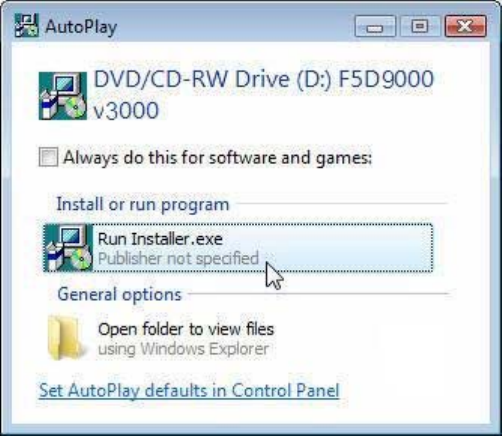
F5D9000 revised manual
Page 8 of 62
- Installation Software CD containing User Manual
-
Installing and Setting up the Card
For users of Windows Vista, refer to the following installation steps:
1A Install
IMPORTANT: INSTALL THE SOFTWARE BEFORE INSERTING THE CARD.
1A.1 Insert the Installation Software CD into your CD-ROM drive.
1A.2 Select the “Run Installer.exe” option.
[***Insert screen shot***]
1A.3 You may see a window titled, “A program needs your permission to
continue”. Click “Continue”.
1A.4 Click “Next” to begin the installation process. [Insert screen shot]
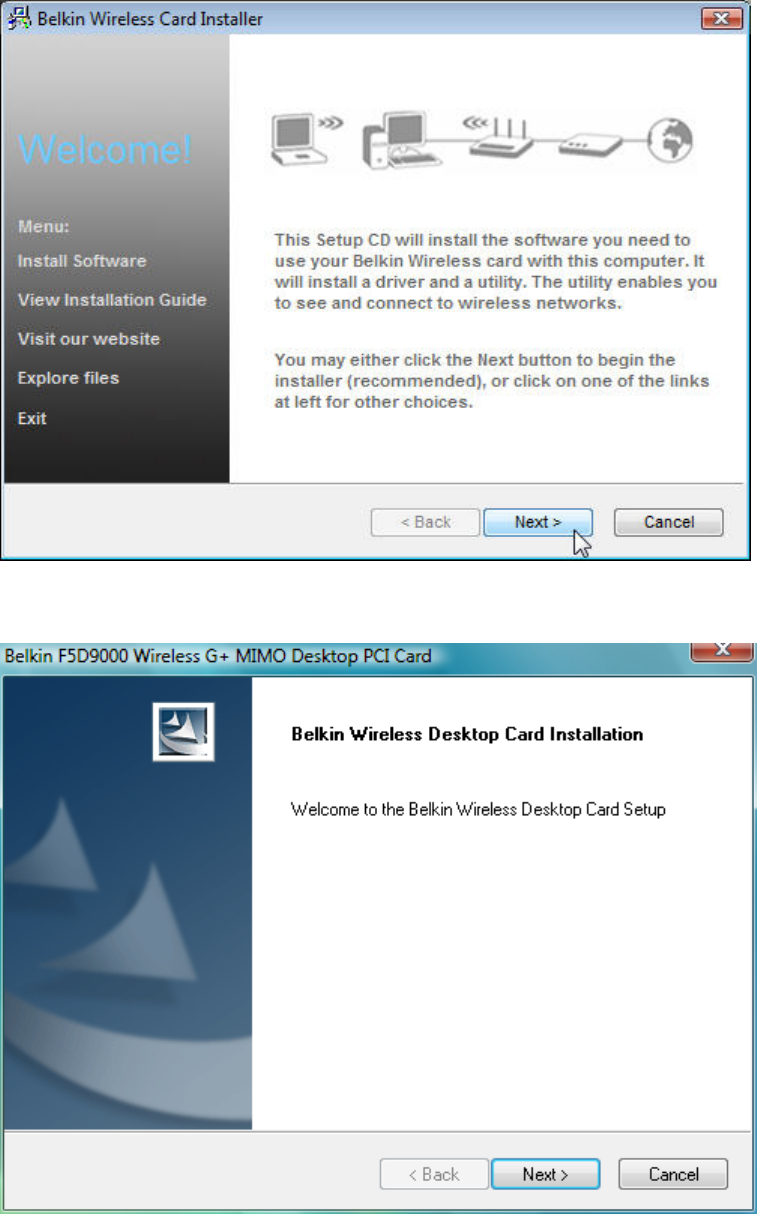
F5D9000 revised manual
Page 9 of 62
1A.5 Click “Next”.
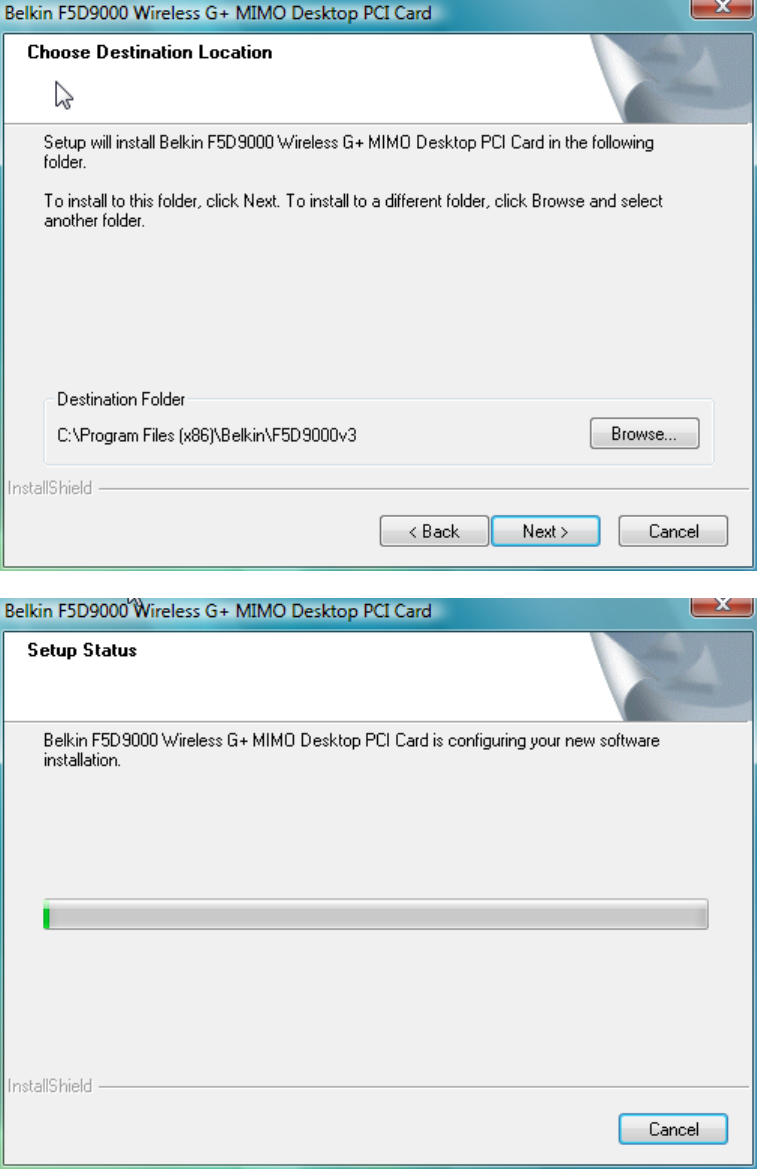
F5D9000 revised manual
Page 10 of 62
1A.6 Select the location of the installation. Click “Next” to continue.
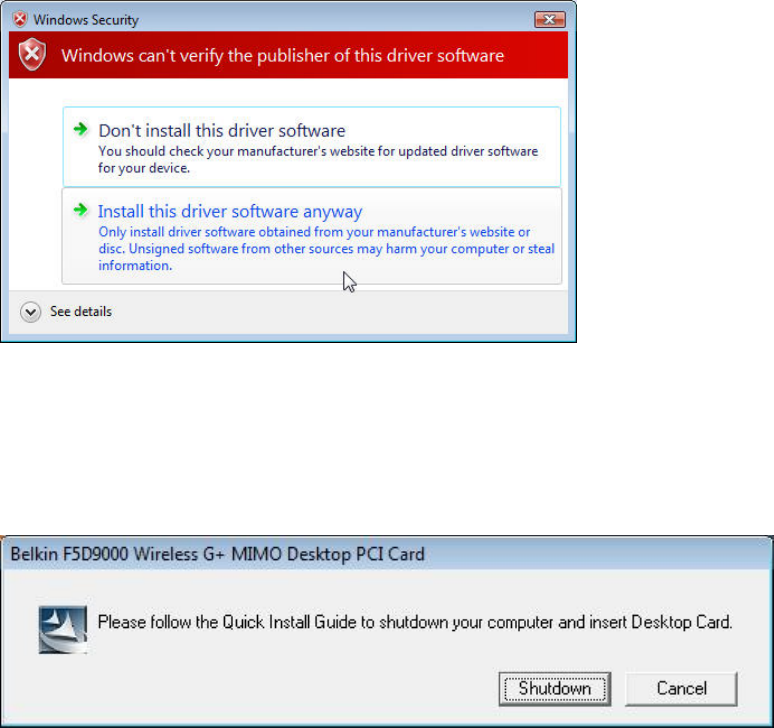
F5D9000 revised manual
Page 11 of 62
1A.7 A window may appear with the message, “Windows can’t verify the
publisher of this driver software” across the top. This is normal and does not
indicate a problem. Our software has been fully tested and is compatible with
this operating system. (Insert screen shot)
1A.8 When prompted, turn off your computer and plug in your Card.
1A.9 Depending on your computer’s operating system version, a window may
appear with the message, “An unidentified program wants access to your
computer” across the top. This is normal and does not indicate a problem. Our
software has been fully tested and is compatible with this operating system.
Please click “Allow”.
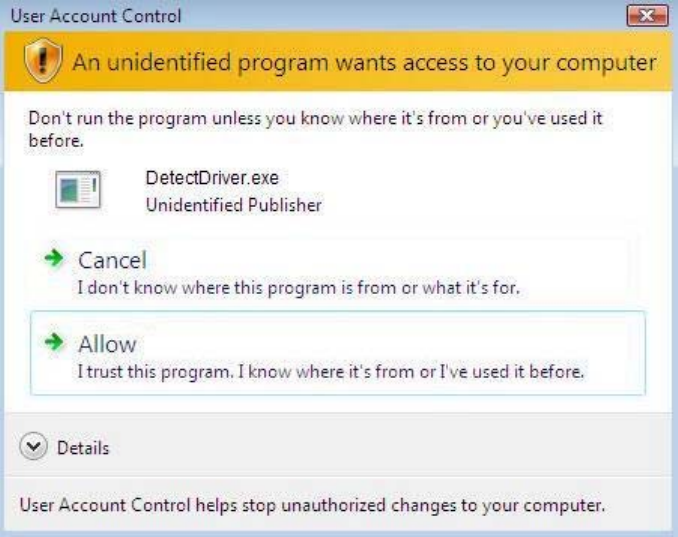
F5D9000 revised manual
Page 12 of 62
1B. Insert
Insert the Card into an Available PCI Slot on your Desktop Computer
1B.1 Shut down your computer and disconnect the power cord.
1B.2 Remove the screws that secure your computer case cover, and remove
the cover.
Note: Touch any metal part of the case to discharge static electricity to avoid
damage to the product or your computer.
1B.3 Locate an empty PCI expansion slot, usually white in color. Confirm that
the Card will fit into it. Keep in mind that the included antenna needs to be
oriented with the top pointing up. If there are cables and other connectors in the
way, choose the PCI slot that has the fewest obstructions to the correct
positioning of the antenna.
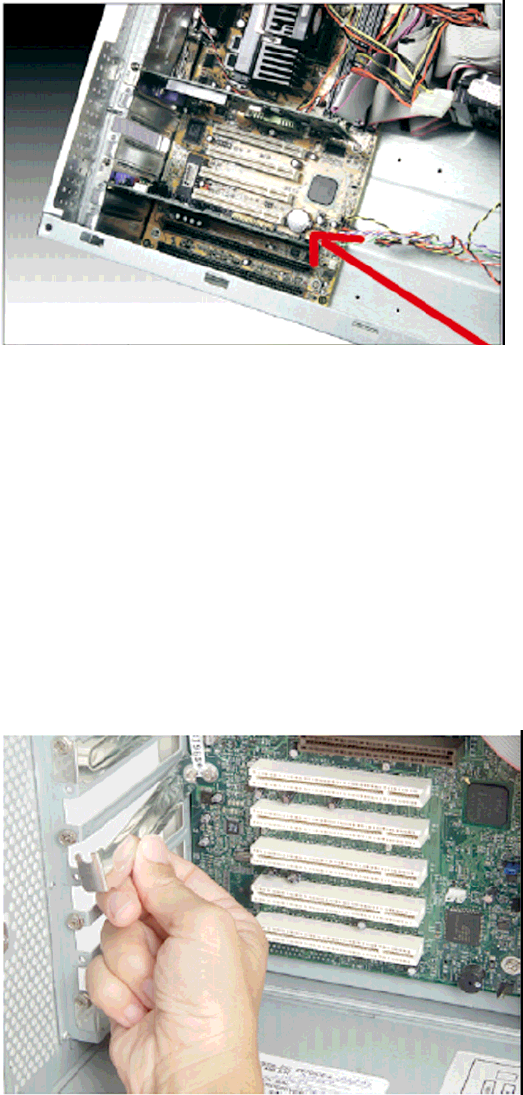
F5D9000 revised manual
Page 13 of 62
1B.4 Remove the metal port cover from the back of the computer that
corresponds to the PCI slot you selected. If there is a screw, put it in a safe place,
as you will be using it to attach the Card to the computer later.
1B.5 Push the Card firmly into the PCI slot that you have chosen. Apply
pressure as needed until the connector is fully seated.
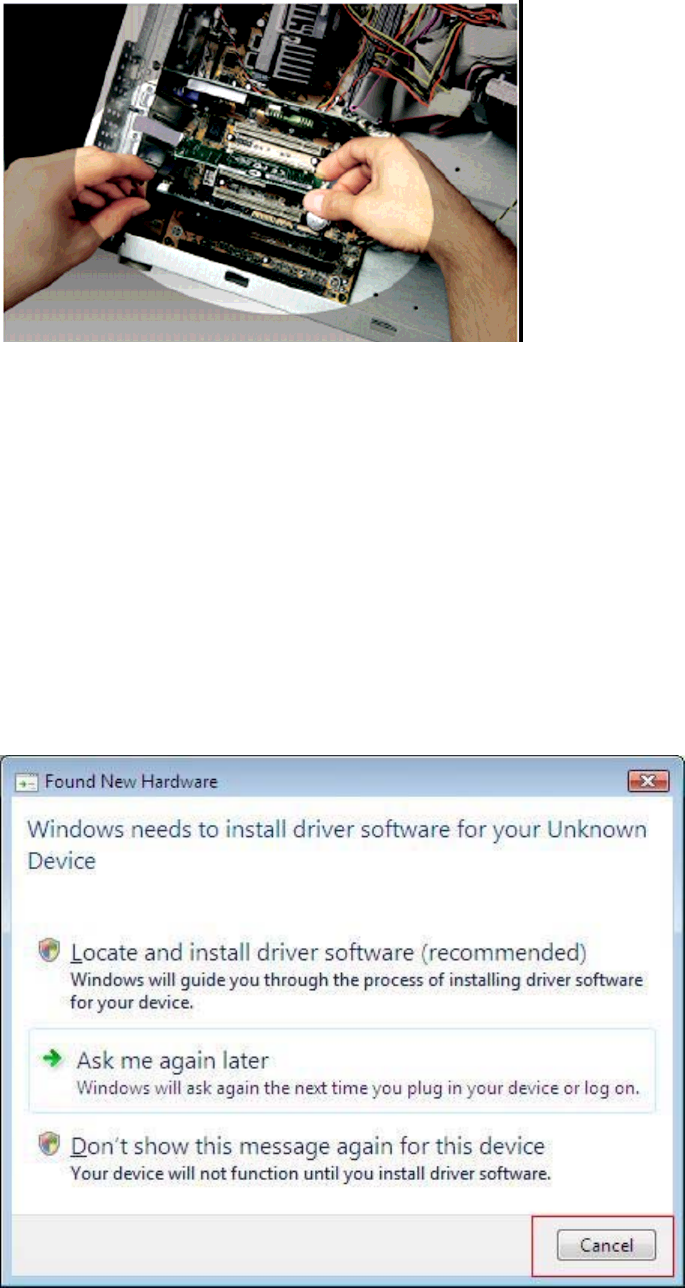
F5D9000 revised manual
Page 14 of 62
1B.6 Now secure the Card with the screw that you previously put aside.
1B.7 Carefully screw the antenna onto the threaded connector on the Card.
Turn the antenna until it is vertical, pointing up.
1B.8 Replace the computer’s cover. Now that the Card is installed, you can
reconnect the power cord and turn the computer back on.
1B.9 Depending on your computer’s operating system version, the “Found New
Hardware Wizard” might appear within 3–15 seconds. If it does, continue to
follow the prompts. Select “Locate and install the driver software” to continue.
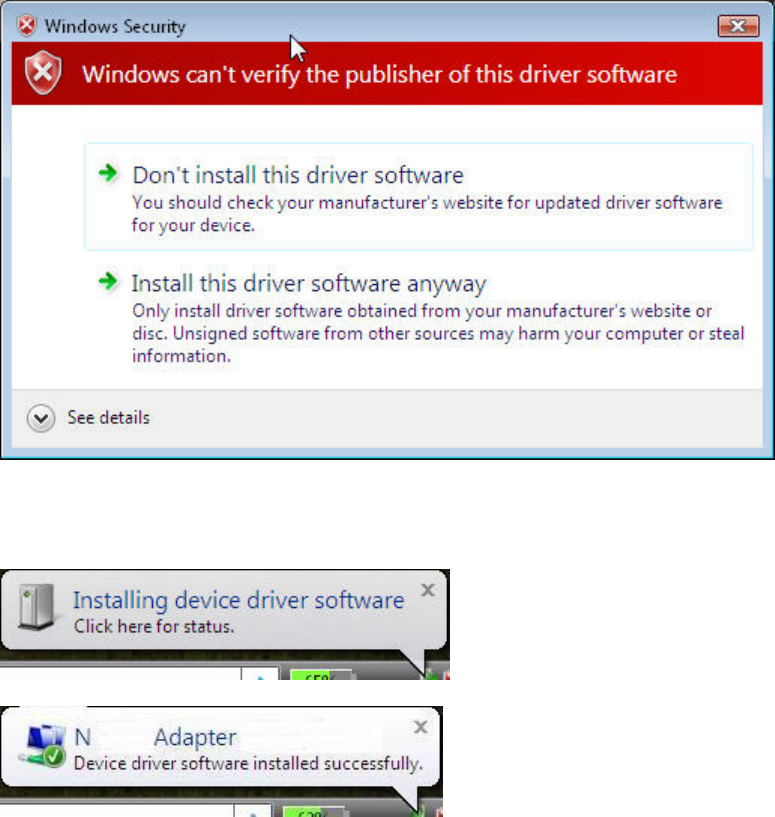
F5D9000 revised manual
Page 15 of 62
1B.10 You might see a screen similar to the one pictured below. This DOES
NOT mean there is a problem. Our software has been fully tested and is
compatible with this operating system. Select “Install this driver software
anyway” and follow the on-screen instructions.
1B.11 Next, a screen appears indicating that hardware installation is taking
place; then, another indicates that the process is complete.
1B.12 Click “Finish” to complete the installation.
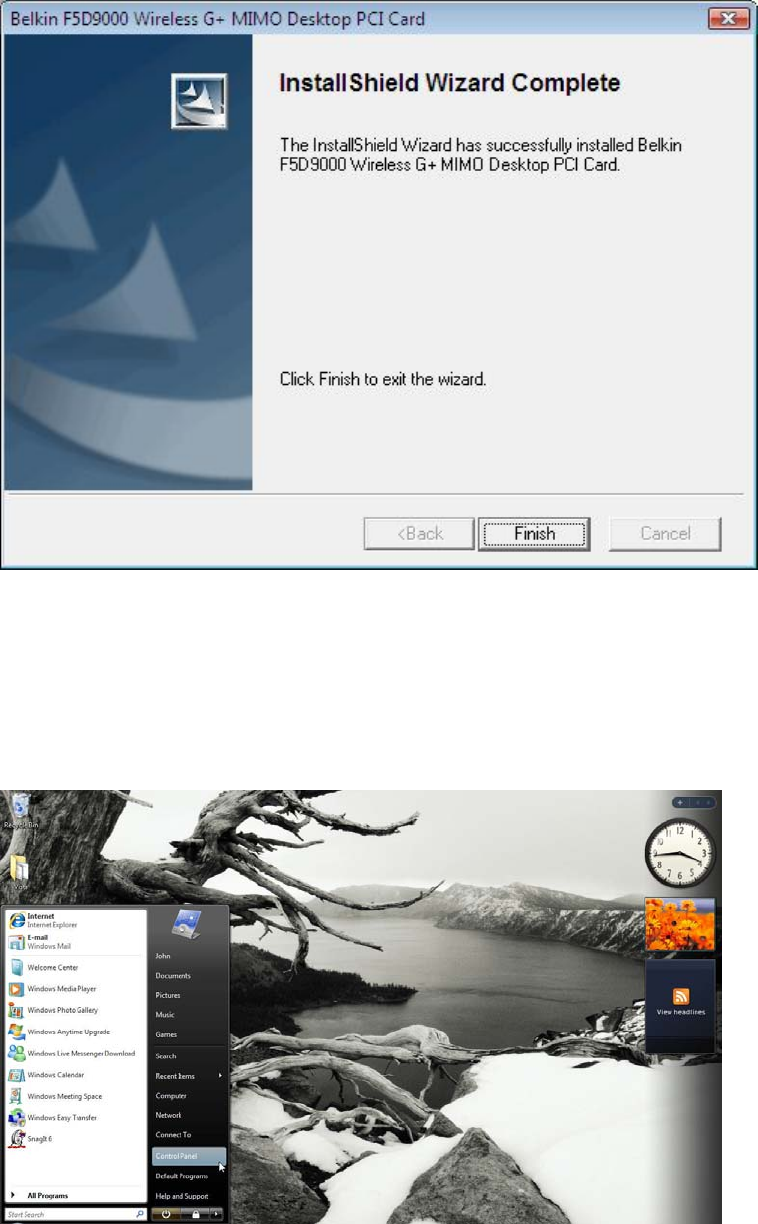
F5D9000 revised manual
Page 16 of 62
1.C Configure
Connect to a Network
1C.1 To connect to the Internet, open the Network and Sharing Center
by first opening the Control Panel from the “Start” menu. (Insert screen shot)
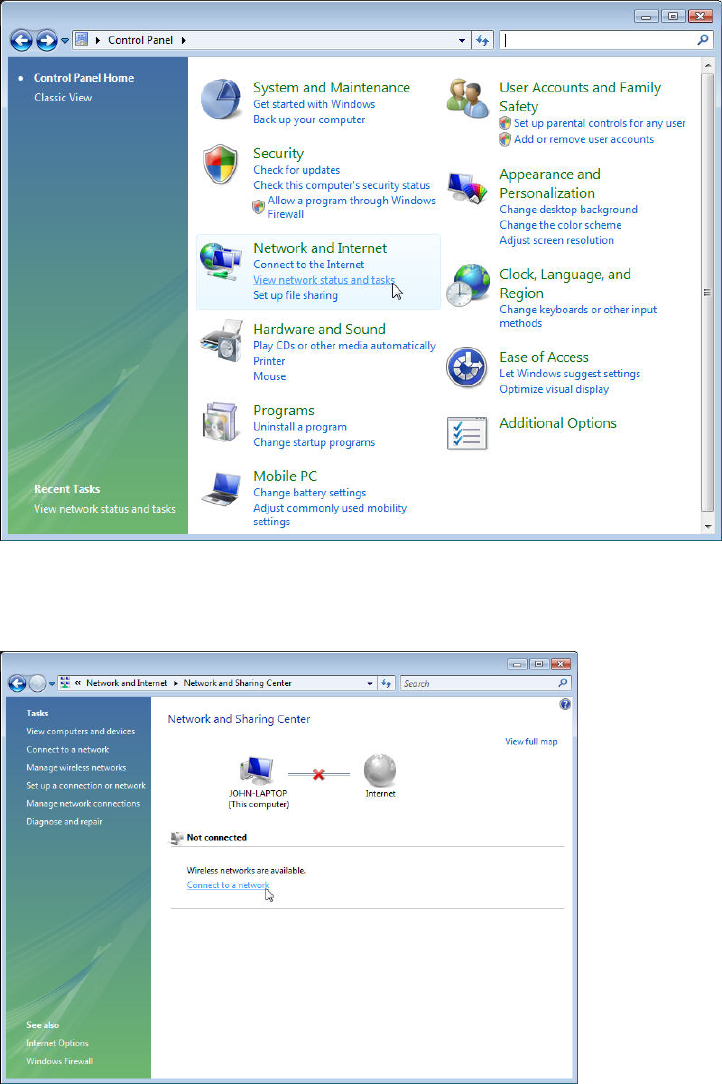
F5D9000 revised manual
Page 17 of 62
1C.2 In the Control Panel, click on “View network status and tasks”.
(Insert screen shot)
1C.3 In the Network and Sharing Center, click on “Connect to a network”.
(Insert screen shot)
1C.4 Select an available wireless network and click “Connect”. (Insert
screen shot)
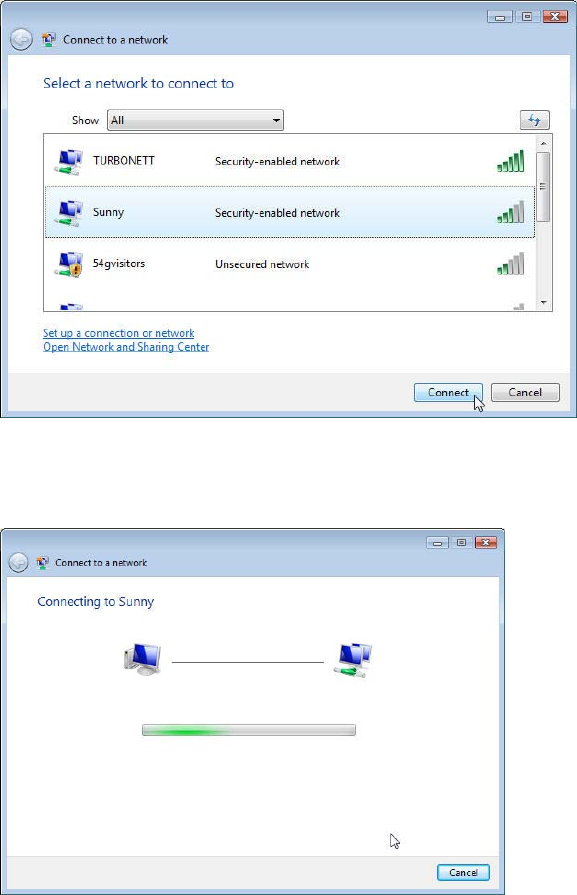
F5D9000 revised manual
Page 18 of 62
1C.5 Your Card will attempt to connect to the selected network. (Insert
screen shot)
1C.6 Depending on the security settings of your wireless network, you
may be prompted to enter in a network security key or a passphrase. Click
“Connect” after you have done so. (Insert screen shot)
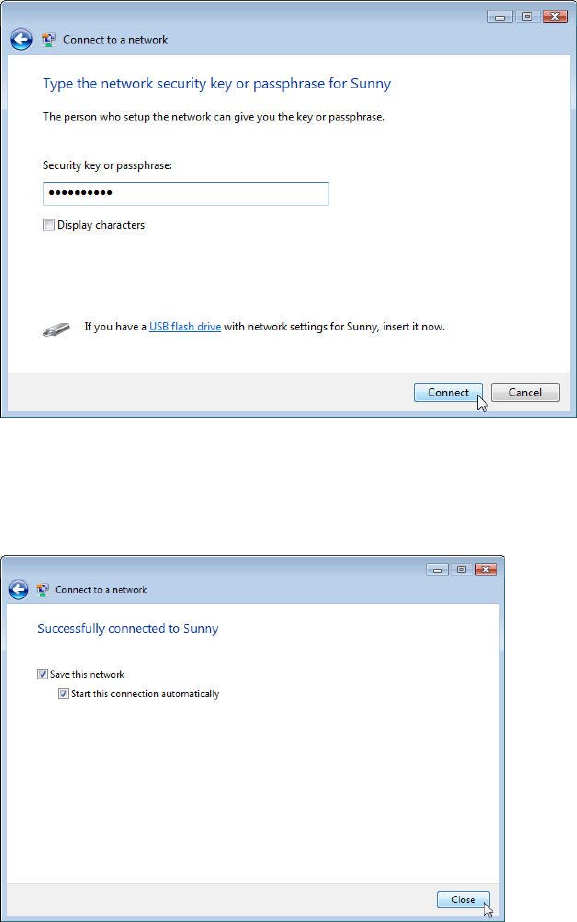
F5D9000 revised manual
Page 19 of 62
1C.7 After connecting to the network, you may choose to save this
network and connect automatically once your Card is in range. (Insert screen
shot)
1C.8 The Network and Sharing Center should now show the network
connection that you have just made. The links on the left of the window allow
you to configure your network connections. (Insert screen shot)
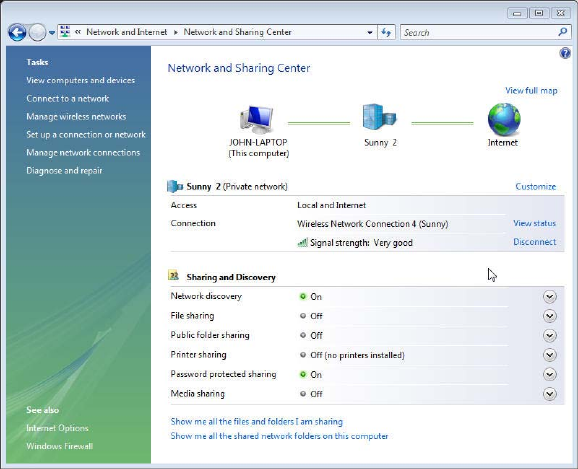
F5D9000 revised manual
Page 20 of 62
For users of other Windows operating systems, refer to the installation
instructions below.
2A Install
IMPORTANT: INSTALL THE SOFTWARE BEFORE INSERTING THE CARD.
2A.1 Insert the Installation Software CD into your CD-ROM drive.
2A.2 The Belkin Wireless Card Installer screen will automatically appear. (This
may take 15–20 seconds.) Click “install” to start the installation.** Insert Screen
shot
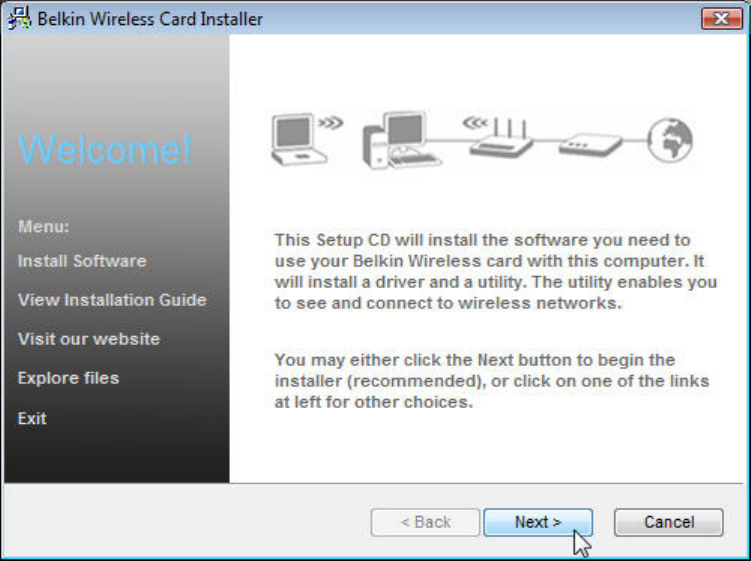
F5D9000 revised manual
Page 21 of 62
Note: If the Belkin Wireless Networking Utility screen does not appear within 20
seconds, access your CD-ROM by double-clicking on the “My Computer” icon;
then, double-click on the CD-ROM drive into which the installation CD has been
placed. Double-click on the folder named “Files”, then double-click on the icon
named “setup.exe”.
2A.3 The InstallShield Wizard will now start. Click “Next” to continue.
[insert 9010-1.tif]
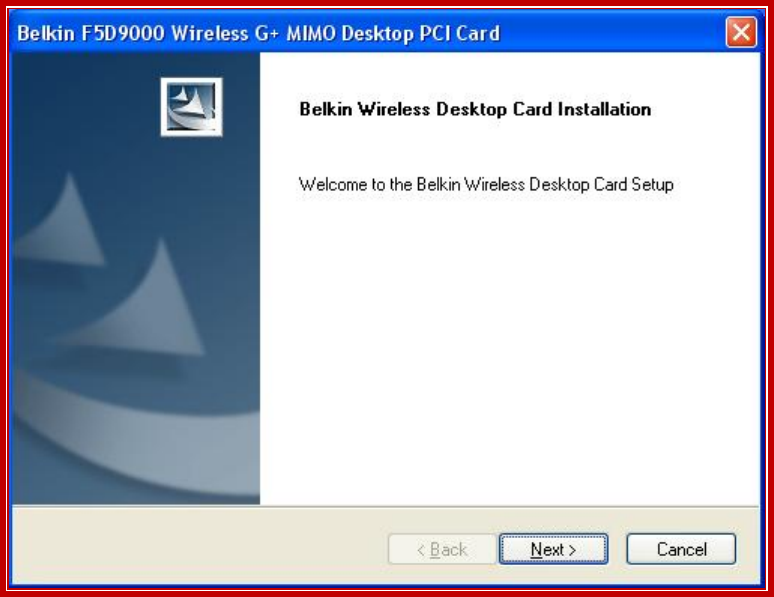
F5D9000 revised manual
Page 22 of 62
2A.4 The first in a series of progress-monitoring screens will let you know
where you are in the setup process. Click “Next” to install in the recommended
destination folder.
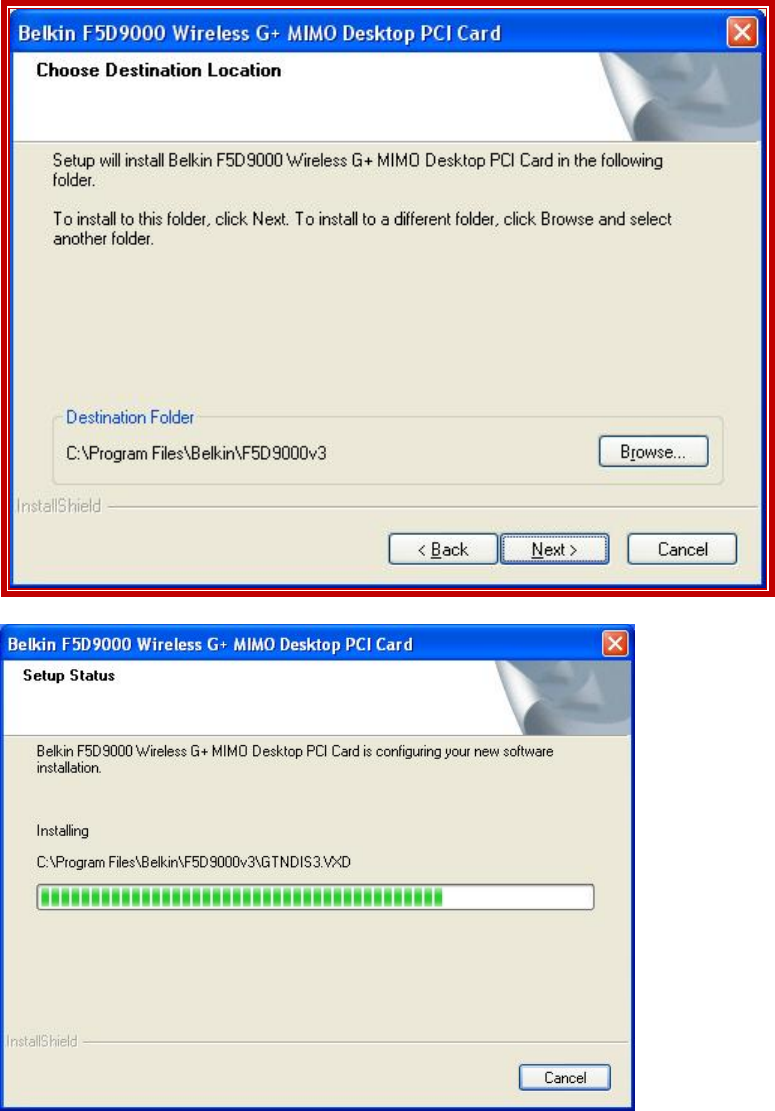
F5D9000 revised manual
Page 23 of 62
2A.5 You might see a screen similar to this one. This DOES NOT mean there is
a problem. Our software has been fully tested and is compatible with this
operating system. Select “Continue Anyway” and follow the on-screen
instructions.
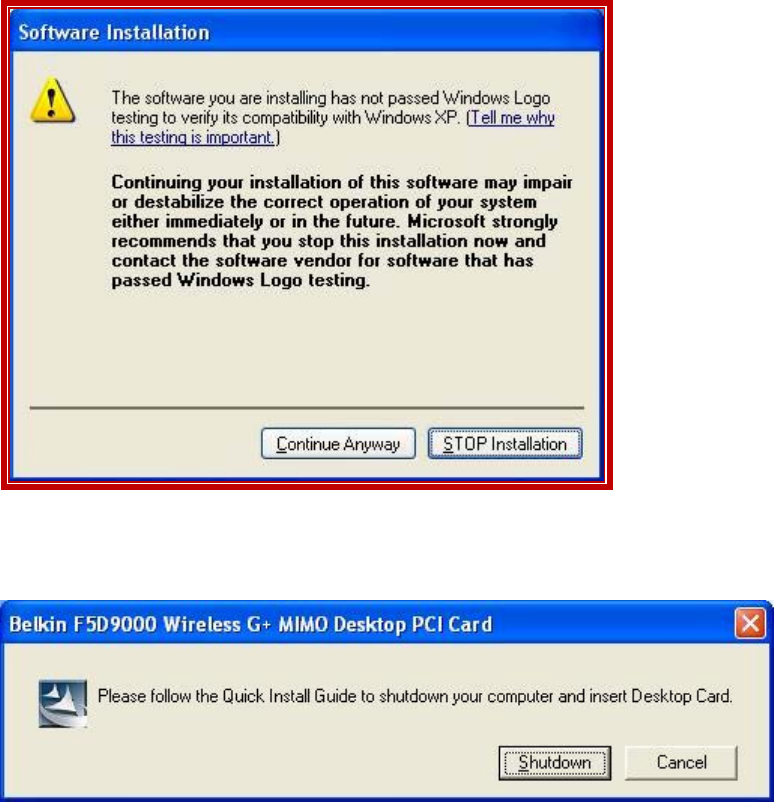
F5D9000 revised manual
Page 24 of 62
2A.6 The dialogue box will ask to shut down the computer and insert the
Desktop Card. Click the “Shutdown” button to shut down your computer.
2B. Insert
Insert the Card into an Available PCI Slot on your Desktop Computer
2B.1 Shut down your computer and disconnect your power cord.
2B.2 Remove the screws behind your computer case that secure the computer
cover and remove the cover.
Note: Touch any metal part of the case to discharge static electricity to avoid
damage to the product or your computer.
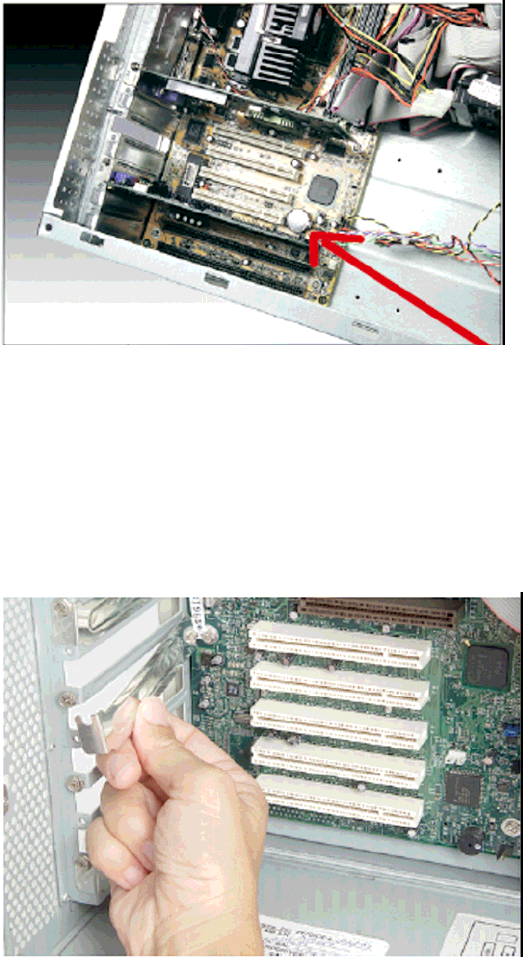
F5D9000 revised manual
Page 25 of 62
2B.3 Locate an empty PCI expansion slot. It is usually white in color. Confirm
that the Card will fit into the slot you have chosen. Keep in mind that the included
antenna needs to be oriented with the top pointing up. If there are cables and
other connectors in the way, try to pick the PCI slot that has the fewest
obstructions to the correct positioning of the antenna.
2B.4 Remove the metal port cover from the back of the computer that
corresponds to the PCI slot you selected. If there is a screw, put it aside in a safe
place, as you will be using it to attach the Card to the computer later.
2B.5 Push the Card firmly into the PCI slot that you have chosen. Apply
pressure as needed until the connector is fully seated.
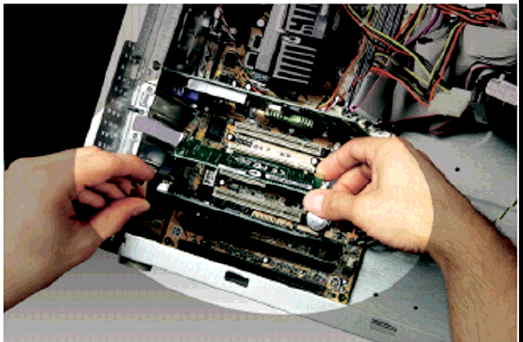
F5D9000 revised manual
Page 26 of 62
2B.6 Now, secure the Card with the screw that you put aside.
2B.7 Carefully screw the antenna onto the threaded connector on the Card.
Turn the antenna until it is vertical, pointing up.
2B.8 Replace the computer’s cover. Now that the Card is installed, you can
reconnect the power cord and turn the computer back on.
2B.9 After reboot, the system will detect the new hardware. Click “No, not this
time” and “Next” to continue.
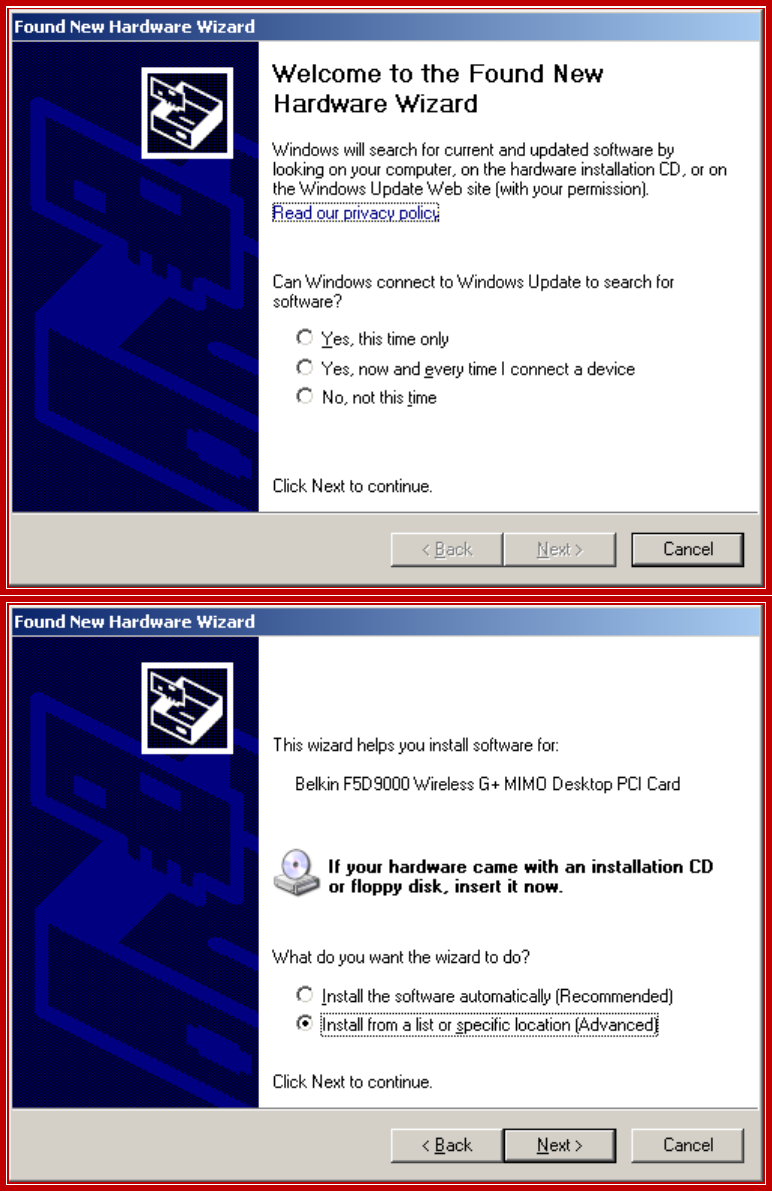
F5D9000 revised manual
Page 27 of 62
2B.10 Depending on your operating system software, you might see a screen
similar to this one. This DOES NOT mean there is a problem. Our software has
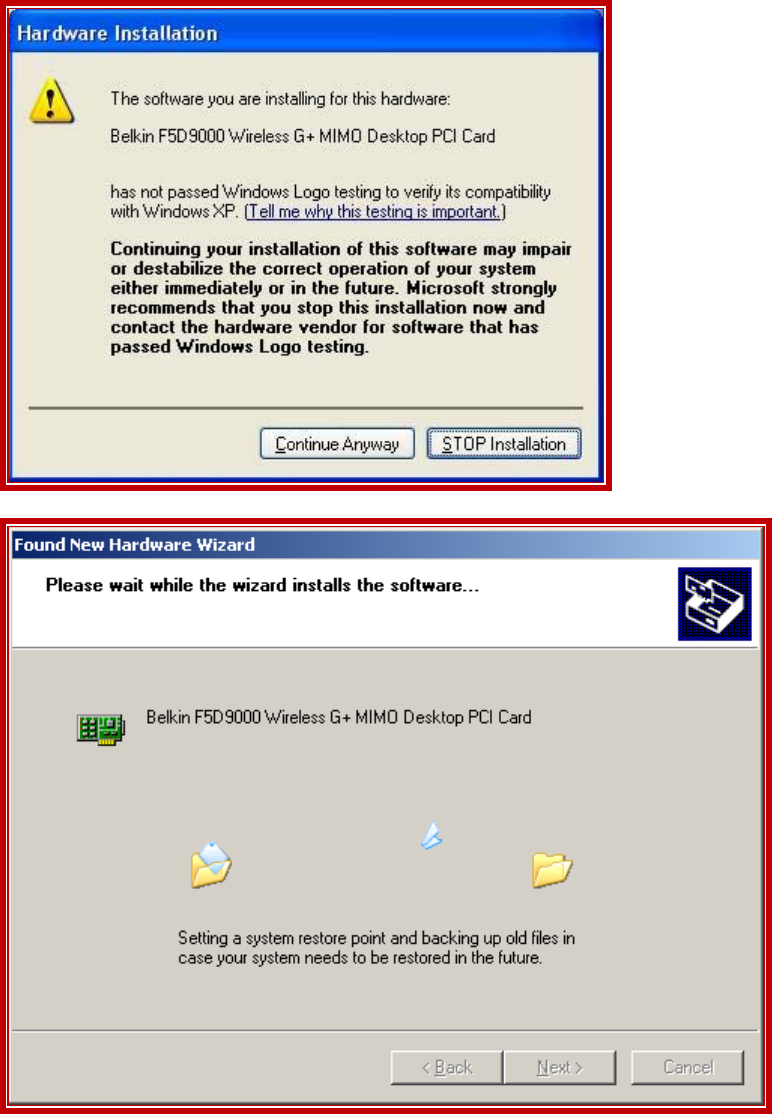
F5D9000 revised manual
Page 28 of 62
been fully tested and is compatible with this operating system. Select “Continue
Anyway” and follow the on-screen instructions.
2B.11 Click “Finish” to complete the software installation.
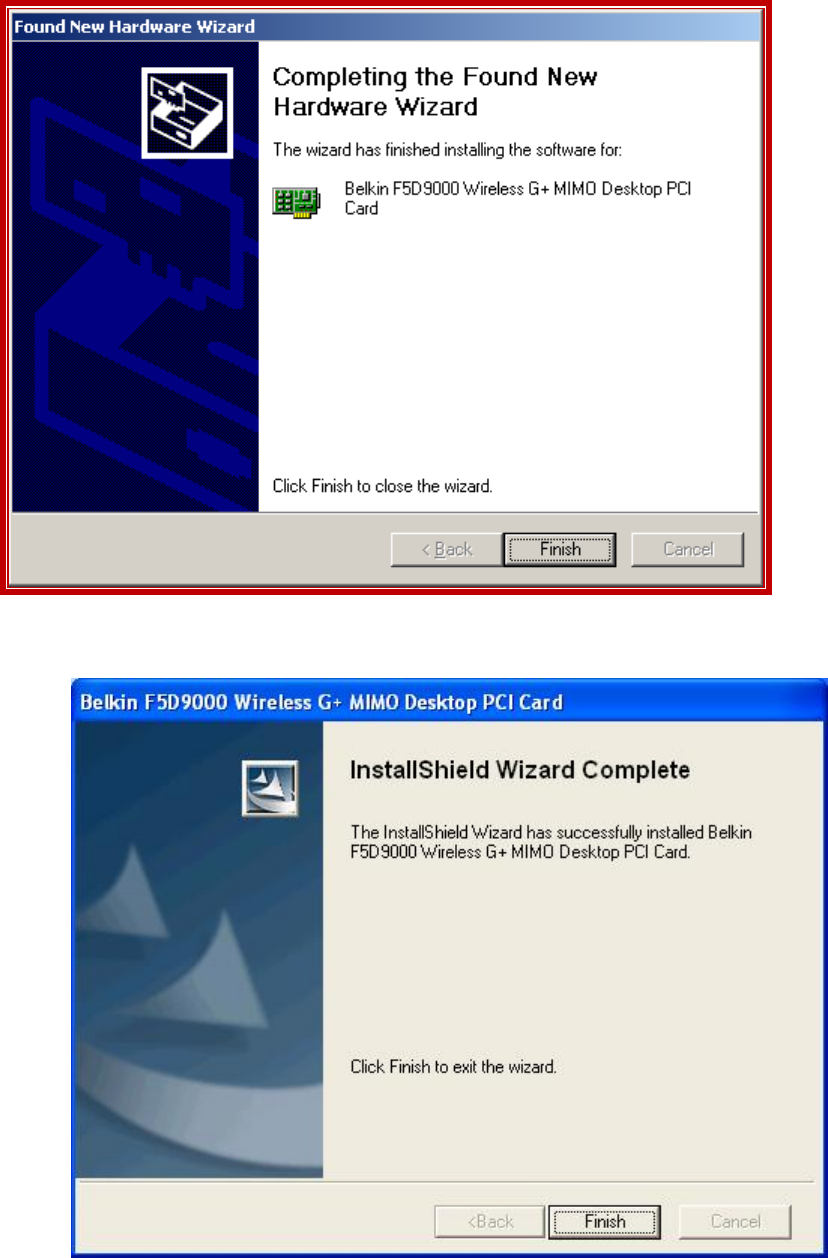
F5D9000 revised manual
Page 29 of 62
2B.12 Click “Finish” to end the installation process.
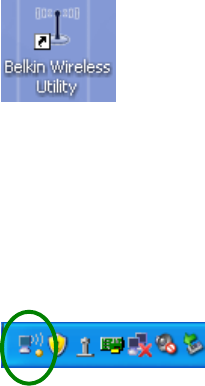
F5D9000 revised manual
Page 30 of 62
2C. Configure
Connect to a Network
Using the Belkin Wireless Networking Utility
2C.1 After restarting your computer, double-click the Belkin Wireless
Networking Utility icon on the desktop screen.
[KEEP THE ICON]
Note: The Belkin Wireless Networking Utility icon can also be found on the
system tray.
[KEEP]
2C.2 The Belkin Wireless Networking Utility screen will appear.
[insert 8013_WNU_Current_Status.tif]
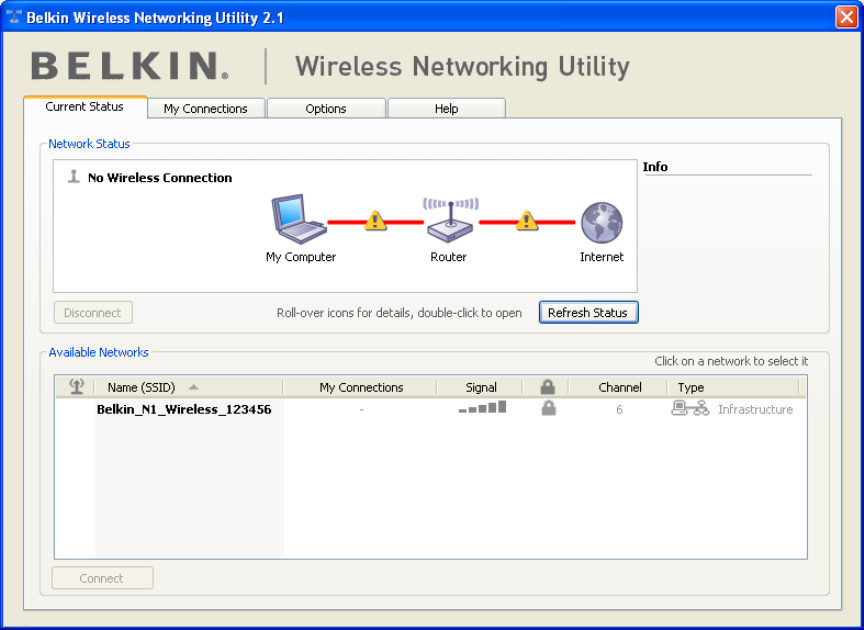
F5D9000 revised manual
Page 31 of 62
2C.3 Select a network to which to connect from the “Available Networks” list
and click “Connect”.
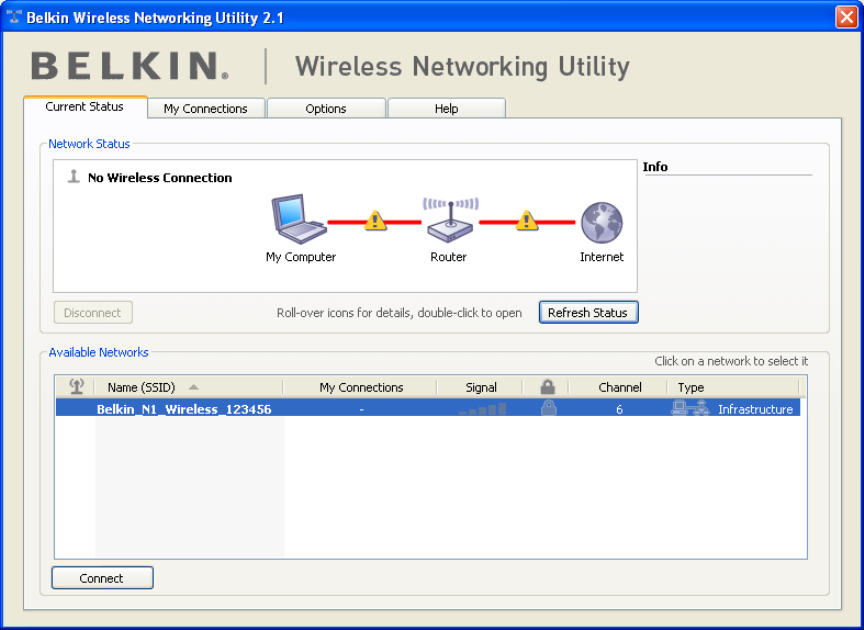
F5D9000 revised manual
Page 32 of 62
Note: In order to see your available networks, you must be near a working
wireless router or access point.
Installation is now complete.
Using the Belkin Wireless Networking Utility
After successfully installing the Belkin Wireless Networking Utility (WNU),
configurations for wireless connection and security are just a few easy clicks
away.
Accessing the Belkin Wireless Networking Utility from the Windows
System Tray
To access the WNU, simply place your mouse pointer and right-click over the
WNU icon on the Windows task tray.
[KEEP] [KEEP]
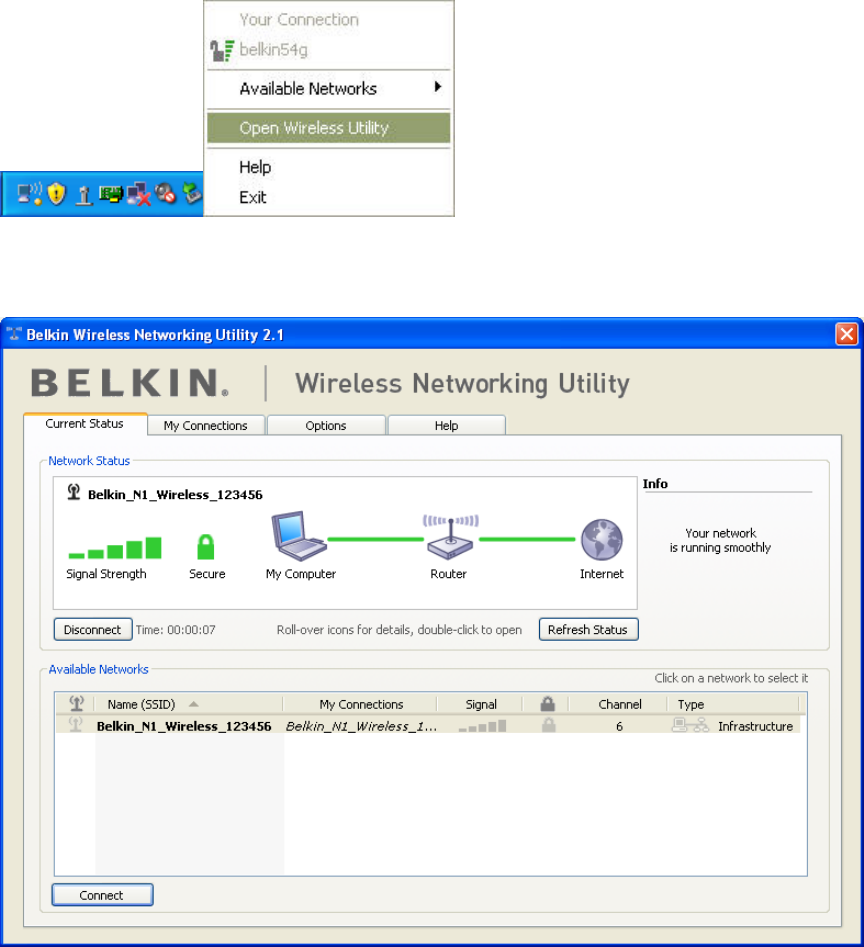
F5D9000 revised manual
Page 33 of 62
If the icon is not present, click on “Start > Programs > Belkin > Belkin Wireless
Utility”.
The WNU’s default screen is the “Current Status” tab. The “Current Status” tab
displays the current Network Status and Available Networks.
Network Status
This window displays the connectivity status of the current network. It even
displays connectivity between the computer and router, and router and Internet.
In the event of a connectivity problem, this window can be used to determine the
problem’s source (e.g. computer, router, or Internet/modem).
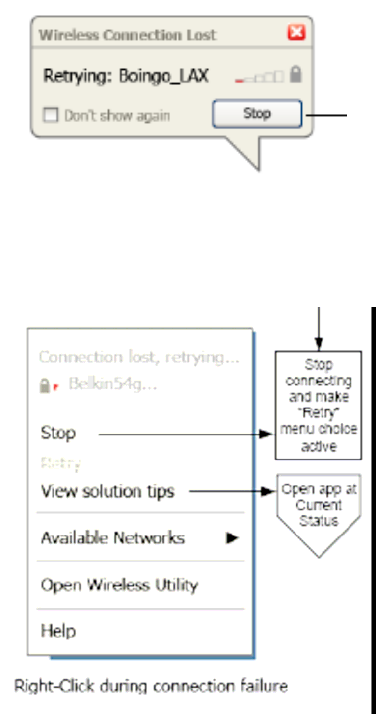
F5D9000 revised manual
Page 34 of 62
Available Networks
This window displays the available networks at the current location as well as
their SSID, Signal Strength, Security Type, Channel, and Network Type.
Lost Wireless Connection
If the current wireless connection is lost, a window will pop up and the WNU will
attempt to reconnect.
Connection Failure
Other options will appear during attempts to reconnect. To stop connecting, click
“Stop” and to reattempt connection, click “Retry”.
Network Status and Solution Tips
To further understand the current Network Status, click “Open Wireless Utility”.
The default screen will be the “Current Status” tab and the “Network Status”
section determines which connections are good and/or faulty.
[insert 8013_WNU_Current_Status_Connected.tif, pls circle the “Info” box and
message]
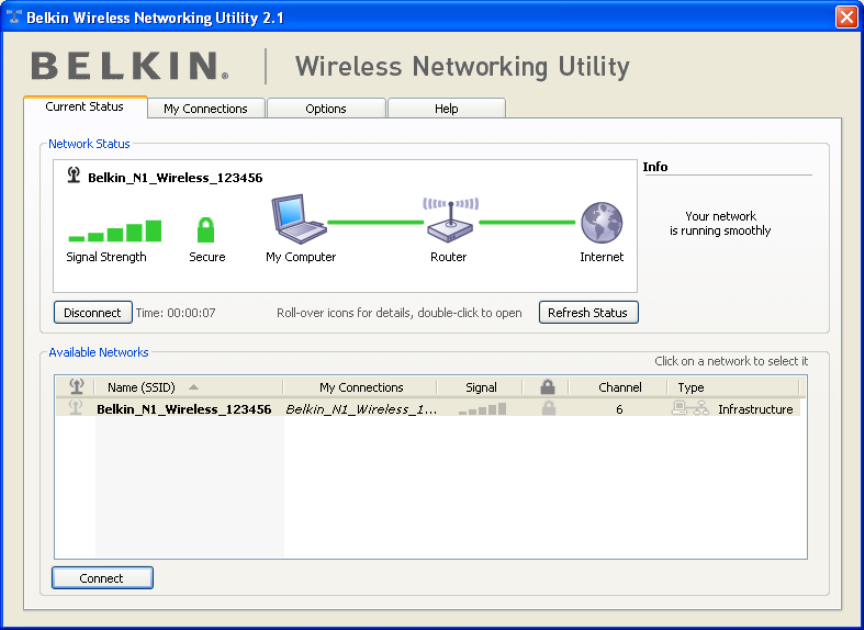
F5D9000 revised manual
Page 35 of 62
The WNU also features a “Solution Tips” section that provides troubleshooting
guidelines.
Setting Wireless Network Profiles
The “My Connections” tab on the WNU allows you to add, edit, and delete
connection profiles. It also displays signal strength, security, and network type.
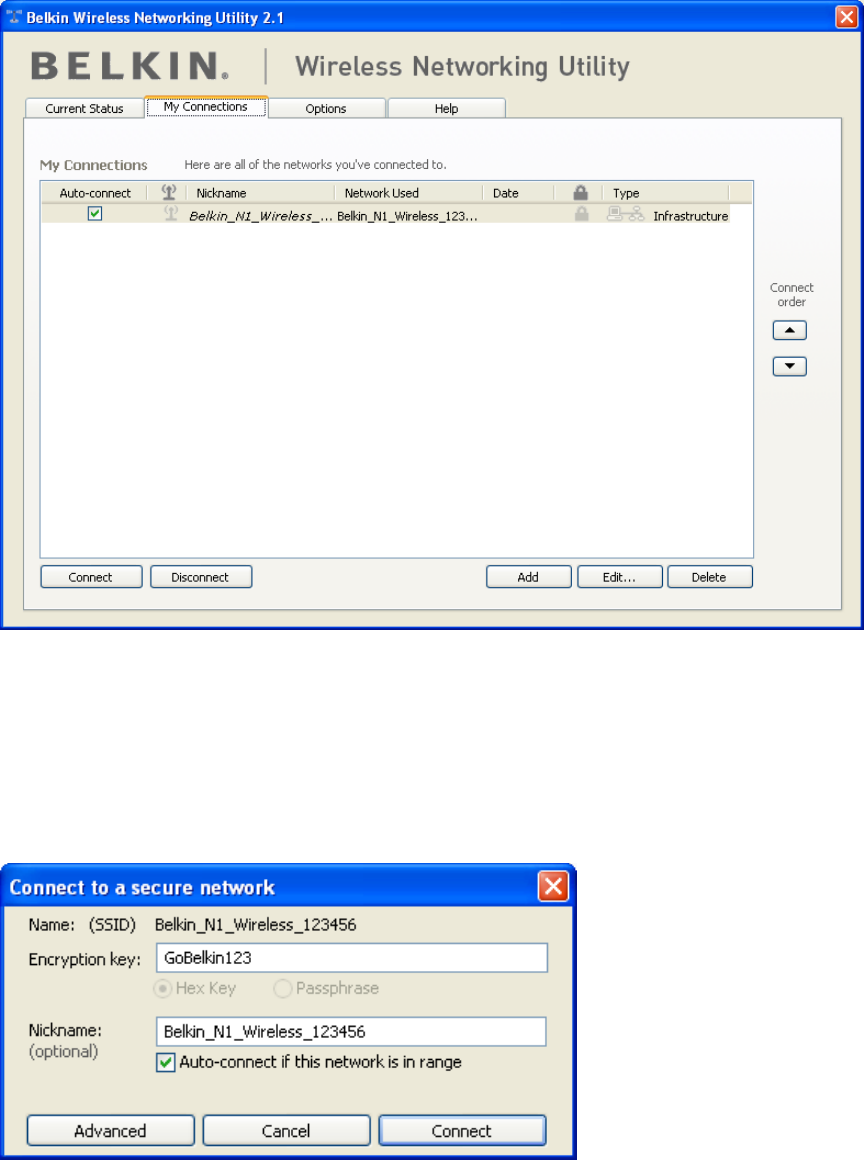
F5D9000 revised manual
Page 36 of 62
Securing your Wi-Fi® Network
If you choose to connect to a secure network, determine the type of security
(WPA or WEP*) and use the appropriate field in the dialog box.
*Note: Types of security
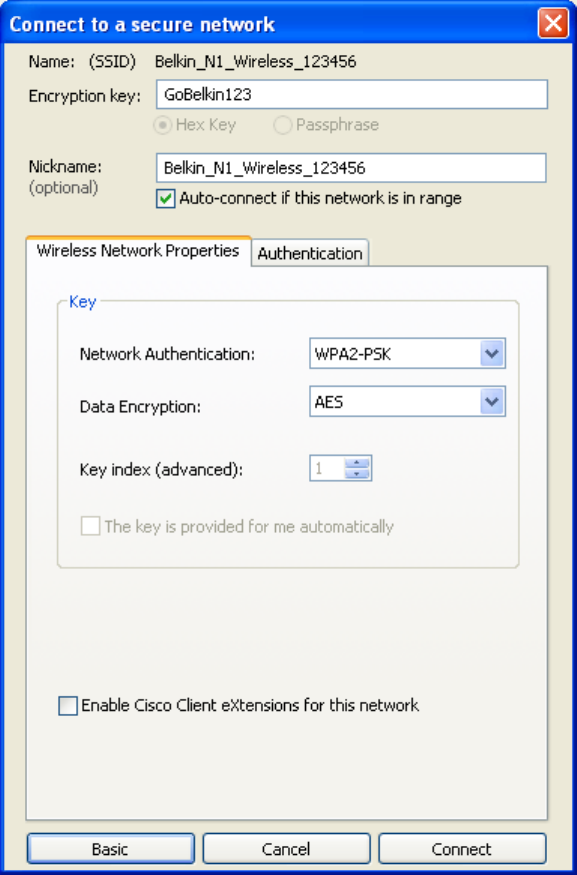
F5D9000 revised manual
Page 37 of 62
Note: When you select a network using encryption, you will first see the simple
security screen. Click the “Advanced” button to see other security options (below).
Wired Equivalent Privacy (WEP) is a less secure, but more widely adopted
wireless security protocol. Depending on the security level (64- or 128-bit), the
user will be asked to input a 10- or 26-character hex key. A hex key is a
combination of letters, a–f, and numbers, 0–9.
Wireless Protected Access (WPA) is the new standard in the wireless security.
However, not all wireless cards and adapters support this technology. Please

F5D9000 revised manual
Page 38 of 62
check your wireless router’s user manual to check if it supports WPA. Instead of
a hex key, WPA uses only passphrases, which are much easier to remember.
The following section, intended for the home, home office, and small office user,
presents a few different ways to maximize the security of your wireless network.
At the time of publication, four Encryption Methods are available:
Encryption Methods:
Using the Belkin Wireless Networking Utility
Name 64-Bit Wired
Equivalent
Privacy
128-Bit
Encryption Wi-Fi
Protected
Access
Wi-Fi
Protected
Access 2
Acronym 64-bit WEP 128-bit WPA-TKIP/AES WPA2-AES
Security Good Better Best Best
Features Static keys Static keys Dynamic key
encryption
and mutual
authentication
Dynamic key
encryption
and mutual
authentication
Encryption
keys
based on
RC4
algorithm
(typically
40-bit keys)
Added
security
over 64-bit
WEP using a
key length of
104 bits, plus
24 additional
bits of
system-
generated
data
TKIP (Temporal
Key Integrity
Protocol)
added so
that keys are
rotated and
encryption is
strengthened
AES
(Advanced
Encryption
Standard)
does not
cause any
throughput
loss
WEP (Wired Equivalent Privacy)
WEP is a common protocol that adds security to all Wi-Fi-compliant wireless
products. WEP gives wireless networks the equivalent level of privacy protection
as a comparable wired network.
64-Bit WEP
64-bit WEP was first introduced with 64-bit encryption, which includes a key
length of 40 bits plus 24 additional bits of system-generated data (64 bits total).
Some hardware manufacturers refer to 64-bit as 40-bit encryption. Shortly after
the technology was introduced, researchers found that 64-bit encryption was too
easy to decode.
F5D9000 revised manual
Page 39 of 62
128-Bit Encryption
As a result of 64-bit WEP’s potential security weaknesses, a more secure
method of 128-bit encryption was developed. 128-bit encryption includes a key
length of 104 bits plus 24 additional bits of system-generated data (128 bits total).
Some hardware manufacturers refer to 128-bit as 104-bit encryption.
Most of the new wireless equipment in the market today supports both 64-bit and
128-bit WEP encryption, but you might have older equipment that only supports
64-bit WEP. All Belkin wireless products will support both 64-bit and 128-bit WEP.
Encryption Keys
After selecting either the 64-bit or 128-bit WEP encryption mode, it is critical that
you generate an encryption key. If the encryption key is not consistent throughout
the entire wireless network, your wireless networking devices will be unable to
communicate with one another.
You can enter your key by typing in the hex key manually, or you can type a
passphrase into the “Passphrase” field and click “Generate” to create a key. A
hex (hexadecimal) key is a combination of numbers and letters from A–F and 0–
9. For 64-bit WEP, you need to enter 10 hex keys. For 128-bit WEP, you need to
enter 26 hex keys.
For instance:
AF 0F 4B C3 D4 = 64-bit WEP key
C3 03 0F AF 0F 4B B2 C3 D4 4B C3 D4 E7 = 128-bit WEP key
The WEP passphrase is NOT the same as a WEP key. Your Card uses this
passphrase to generate your WEP keys, but different hardware manufacturers
might have different methods on generating the keys. If you have multiple
vendors’ equipment in your network, the easiest thing to do is to use the hex
WEP key from your wireless router (or
access point) and enter it manually into the hex WEP key table in your Card’s
configuration screen.
WPA (Wi-Fi Protected Access)
WPA (Wi-Fi Protected Access) is a new Wi-Fi standard that improves upon the
security features of WEP. To use WPA security, the drivers and software of your
wireless equipment must be upgraded to support it. These updates will be found
on your wireless vendor’s website. There are three types of WPA security: WPA-
PSK (no server), WPA (with radius server), and WPA2
F5D9000 revised manual
Page 40 of 62
WPA-PSK (no server) uses what is known as a pre-shared key as the network
key. A network key is a password that is between eight and 63 characters long. It
can be a combination of letters, numbers, or characters. Each client uses the
same network key to access the network. Typically, this is the mode that will be
used in a home
environment.
WPA (with radius server) works best in a business environment, in which a
radius server automatically distributes the network key to clients.
WPA2 requires Advanced Encryption Standard (AES) for encryption of data,
which offers much greater security than WPA. WPA uses both Temporal Key
Integrity Protocol (TKIP) and (AES) for encryption.
Most Wi-Fi products ship with security turned off. So once you have your network
working, you need to activate WEP or WPA and make sure all your wireless
devices are sharing the same network key.
Setting up your Belkin Wireless Router (or Access Point) to use Security
To start using security, you need to first enable WEP or WPA for your wireless
router (or access point). For Belkin Wireless Routers (or Access Points), these
security features can be configured by using the web-based interface. See your
wireless router’s (or access point’s) manual for directions on how to access the
management interface.
IMPORTANT: You must now set all wireless network cards/adapters to match
these settings.
Configuring your Belkin Wireless G Plus MIMO Desktop Card to use
Security
At this point, you should already have your wireless router (or access point) set
to use WPA or WEP. In order for you to gain a wireless connection, you will need
to set your Wireless G Plus MIMO Desktop Card to use the same security
settings.
Changing the Wireless Security Settings
The Belkin Wireless G Plus MIMO Desktop Card supports the latest WPA
security feature as well as the legacy WEP security standard. By default, wireless
security is disabled.
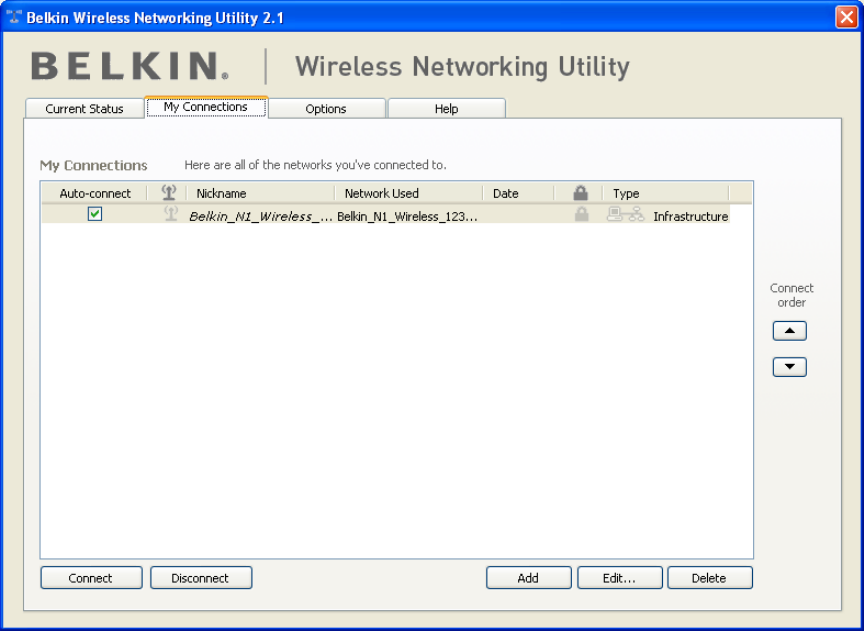
F5D9000 revised manual
Page 41 of 62
To enable security, you will first need to determine which standard is used by the
router or access point. (See your wireless router’s or access point’s manual for
directions on how to access the security settings.)
[insert F5D9000-18.jpg]
To access the security settings on your Card, click the “My Connections” tab and
point to the connection for which you want to change security settings. Click
“Edit” to change settings.
WEP Setup
64-Bit WEP Encryption
1. Select “WEP” from the drop-down menu.
2. After selecting your WEP encryption mode, you can enter your key by typing in
the hex key manually, or you can type in a passphrase in the “Passphrase” field
and click “Generate” to create a key.
A hex (hexadecimal) key is a combination of numbers and letters from A–F and
0–9. For 64-bit WEP, you need to enter 10 hex keys.
For instance:
AF 0F 4B C3 D4 = 64-bit WEP key
[insert F5D9000-15.jpg]
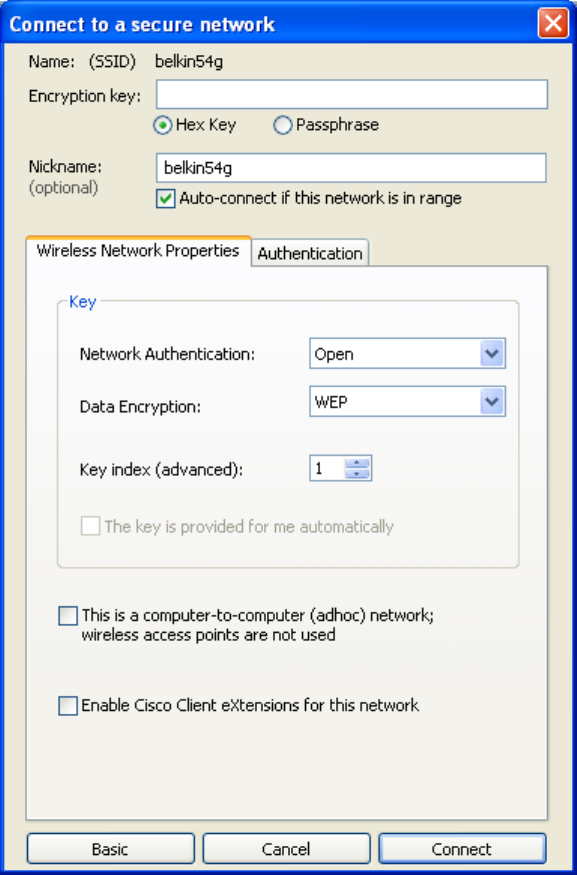
F5D9000 revised manual
Page 42 of 62
3. Click “Save” to finish. Encryption in the wireless router
(or access point) is now set. Each of your computers on your
wireless network will now need to be configured with the same
security settings.
WARNING: If you are using a wireless client to turn on the security
settings in your wireless router (or access point), you will temporarily
lose your wireless connection until you activate security on your
wireless client. Please record the key prior to applying changes in the wireless
router (or access point). If you don’t remember the hex key, your client will be
locked out of the wireless router (or access point).
128-Bit WEP Encryption
1. Select “WEP” from the drop-down menu.
2. After selecting your WEP encryption mode, you can enter your
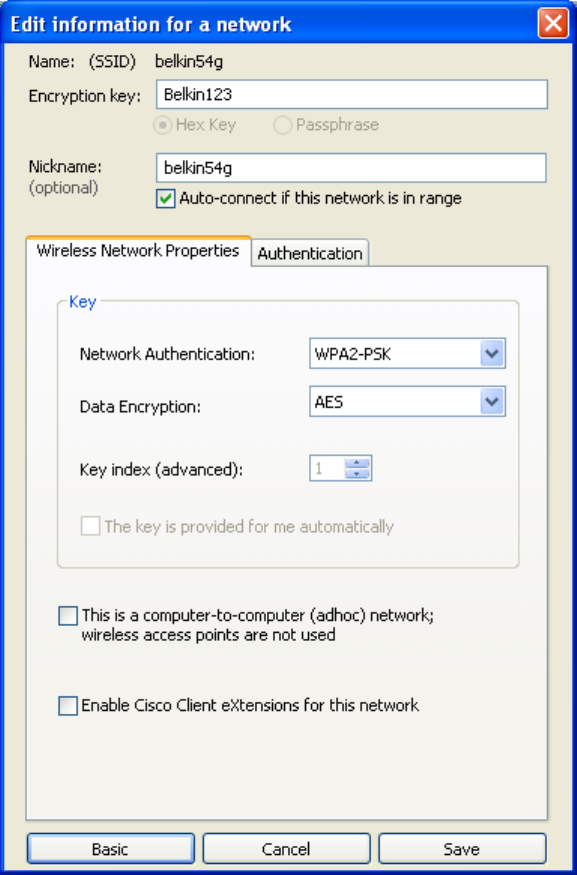
F5D9000 revised manual
Page 43 of 62
key manually by typing in the hex key manually, or you can type
in a passphrase in the “Passphrase” field and click “Generate” to
create a key.
A hex (hexadecimal) key is a combination of numbers and letters from
A–F and 0–9. For 128-bit WEP, you need to enter 26 hex keys.
For instance:
C3 03 0F AF 0F 4B B2 C3 D4 4B C3 D4 E7 = 128-bit WEP key
[insert F5D9000-16.jpg]
3. Click “Save” to finish. Encryption in the wireless router
(or access point) is now set. Each of the computers on your
wireless network will now need to be configured with the same
security settings.
F5D9000 revised manual
Page 44 of 62
WARNING: If you are using a wireless client to turn on the security
settings in your wireless router (or access point), you will temporarily
lose your wireless connection until you activate security on your
wireless client. Please record the key prior to applying changes in the wireless
router (or access point). If you don’t remember the hex key,
your client will be locked out of the wireless router (or access point).
WPA-PSK (no server)
Choose this setting if your network does not use a radius server.
WPA-PSK (no server) is typically used in home and small
office networking.
1. From the “Network Authentication” drop-down menu, select “WPA-PSK (no
server)”.
2. Enter your network key. This can be from eight to 63 characters and can be
letters, numbers, or symbols. This same key must be used on all of the clients
(network cards) that you want to include in your network.
[insert F5D9000-17.jpg]
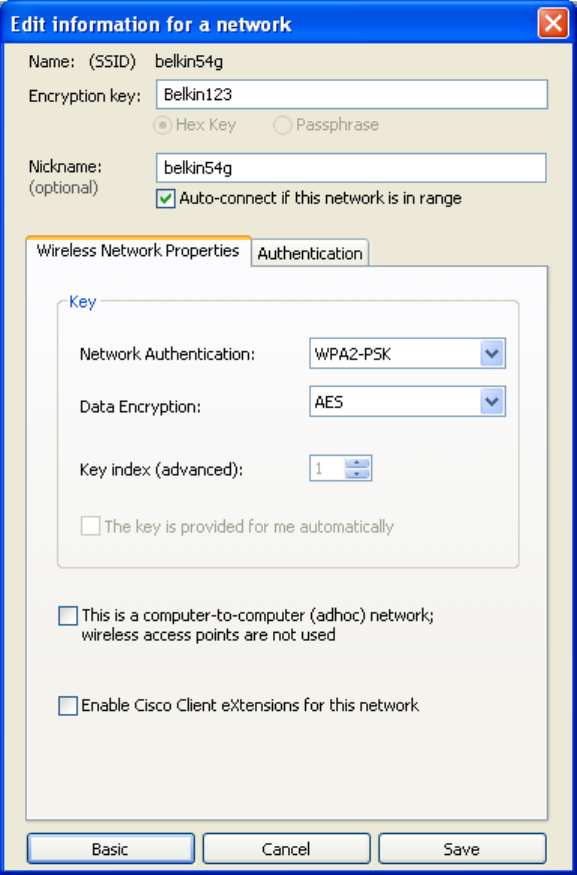
F5D9000 revised manual
Page 45 of 62
3. Click “Save” to finish. You must now set all clients (network cards) to match
these settings.
Wireless Networking Utility Options
[insert F5D9000-19.jpg]
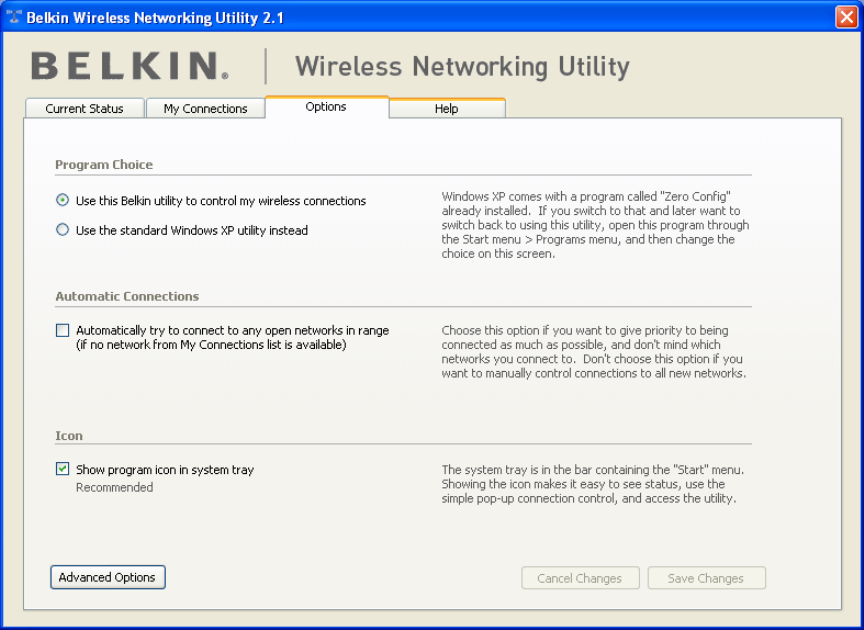
F5D9000 revised manual
Page 46 of 62
The “Options” tab on the WNU provides the user the ability to customize his or
her WNU settings.
Wireless Networking Utility Help
The WNU “Help” tab provides users with access to online and telephone support,
as well as advanced diagnostic tools.
[insert F5D9000-20.jpg]
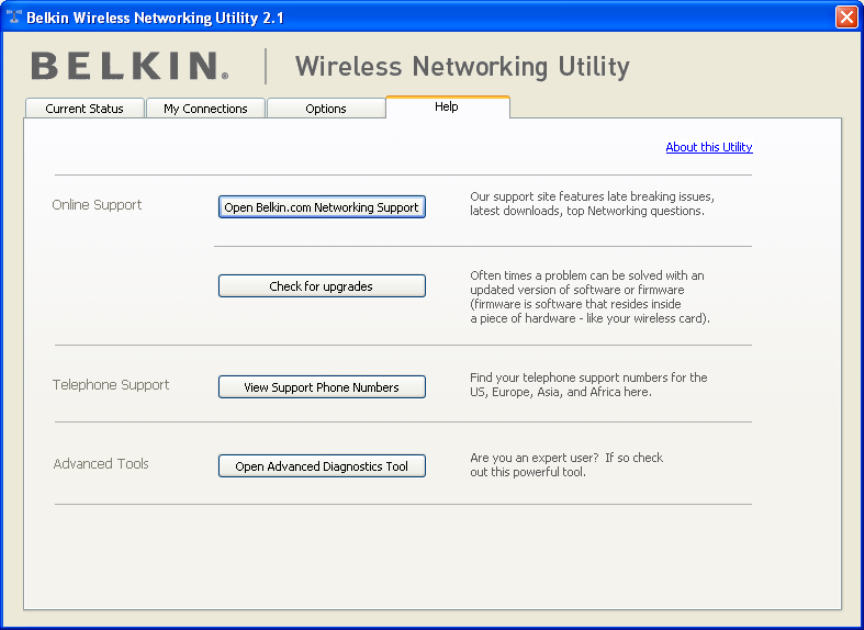
F5D9000 revised manual
Page 47 of 62
Advanced Diagnostic Tools
The “Advanced Diagnostic Tools” section is the central control panel for all the
settings of the hardware and software components of the wireless network. It
provides an array of tests and connectivity services to ensure optimal network
performance.
[insert F5D9000-21.jpg]
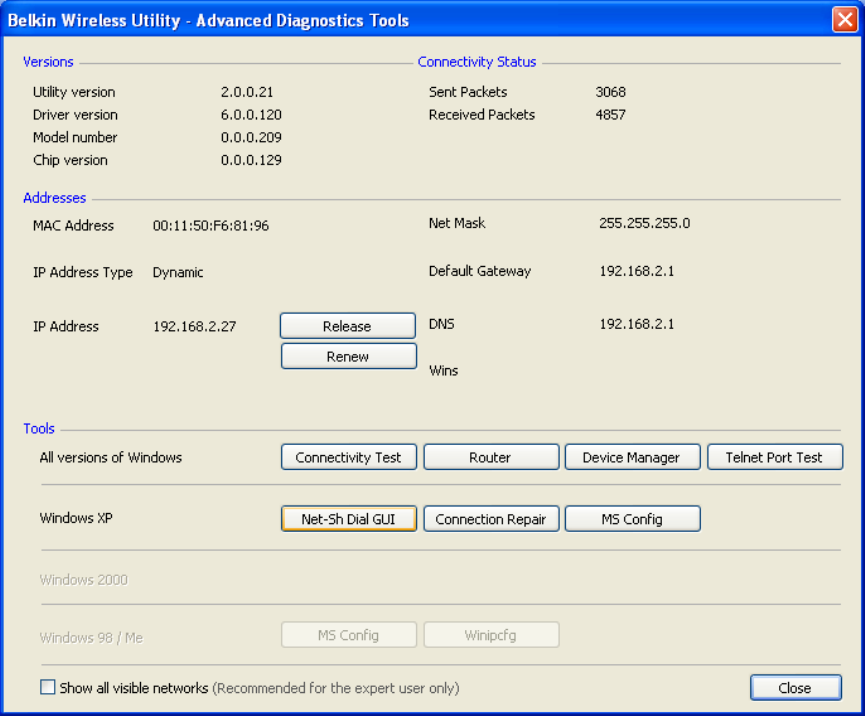
F5D9000 revised manual
Page 48 of 62
Troubleshooting
I can’t connect to the Internet wirelessly.
If you are unable to connect to the Internet from a wireless computer, please
check the following items:
1. Look at the lights on your wireless router. If you’re using a Belkin Wireless
Router, the lights should be as follows:
• The “Power” light should be on.
• The “Connected” light should be on, and not blinking.
• The “WAN” light should be either on or blinking.
If your Belkin Wireless Router’s lights match these descriptions, go to number 2,
below.
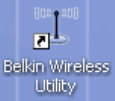
F5D9000 revised manual
Page 49 of 62
If this is NOT the case, please contact Belkin technical support.
If you are not using a Belkin Wireless Router, consult that router manufacturer’s
user guide.
2. Open your Wireless Networking Utility software by clicking on the icon in the
system tray at the bottom right-hand corner of the screen. If you’re using a Belkin
Wireless Card, the tray icon should look like this (the icon may be red or green):
3. The exact window that opens will vary depending on the model of wireless
card you have; however, any of the utilities should have a list of “Available
Networks”. Available networks are wireless networks you can connect to.
If you are using a Belkin 802.11g (54g) Router, “Belkin54g” is the default name.
If you are using a Belkin 802.11b Router, the default name should be “WLAN”.
If you are NOT using a Belkin Router, please consult your router manufacturer’s
user manual for the default name.
The name of your wireless network appears in “Available Networks”.
If the correct network name is listed in the “Available Networks” list, please follow
the steps below to connect wirelessly:
1. Click on the correct network name in the “Available Networks” list.
2. If the network has security (encryption) enabled, you will need to enter the
network key. For more information regarding security, please see “Securing your
Wi-Fi® Network” on page 23 of this manual.
3. Within a few seconds, the tray icon in the lower right-hand corner of your
screen should turn green, indicating a successful connection to the network.
If you are still unable to access the Internet after connecting to the wireless
network, please contact Belkin Technical Support.
The name of your wireless network DOES NOT appear in the list of
“Available Networks”.
If the correct network name is not listed under “Available Networks” in the
Wireless Networking Utility, please attempt the following troubleshooting steps:
1. Temporarily move computer, if possible, to five to 10 feet away from the
Wireless Router (or Access Point). Close the Wireless Networking Utility,
F5D9000 revised manual
Page 50 of 62
and reopen it. If the correct network name now appears under “Available
Networks”, you may have a range or interference problem. Please see the
suggestions listed in the “Placement of your Wireless Networking
Hardware for Optimal Performance” section on page 2.
2. Using a computer that is connected to the Wireless Router (or Access
Point) via a network cable (as opposed to wirelessly), ensure that
“Broadcast SSID” is enabled. This setting is found on the Router’s
wireless “Channel and SSID” configuration page. For detailed instructions
on accessing this page and changing settings, please see your Wireless
Router’s (or Access Point’s) User Manual.
If you are still unable to access the Internet after completing these steps, please
contact Belkin Technical Support.
Installation CD-ROM does not start Wireless Networking Utility.
If the CD-ROM does not start the Wireless Networking Utility automatically, it
could be that the computer is running other applications that are interfering with
the CD drive.
If the Wireless Networking Utility screen does not appear within 15-20 seconds,
open up your CD-ROM drive by double-clicking on the “My Computer” icon. Next,
double-click on the CD-ROM drive that the Installation CD has been placed in to
start the installation. Then, double-click on the folder named “Files”. Next,
double-click on the icon named “Setup.exe”.
Power LED does not come ON; Card is not working.
If the LED indicators are not ON, the problem may be that the Card is not
connected or installed properly.
Verify that the Card is plugged firmly into the PCI slot of your computer. Check to
see that the drivers for the Card have been installed. Right-click on the “My
Computer” icon on your desktop. Choose “Properties” and navigate to the
“Device Manager” and see if your Card is listed without any errors. If an error is
indicated, contact Belkin Technical Support.
Link LED is blinking slowly; cannot connect to a wireless network or the
Internet.
If your Card appears to be functioning properly, but you cannot connect to a
network or you have a red wireless icon at the bottom of your screen, the
problem may be that there is a mismatch between the network name (SSID)
settings in your wireless network properties.
F5D9000 revised manual
Page 51 of 62
Check the SSID settings to see if they match. The SSID is case-sensitive and the
spelling on each computer must be exactly the same in order for the Card to
connect to the wireless router (or access point).
Note: To check the SSID settings or look for an available network, double-click
the Signal Indicator icon to bring up the “Wireless Networks” screen. Click “Add”
if you do not see the network you are trying to connect to and type in the SSID.
For more information about setting up an SSID, please refer to your router
manufacturer’s user manual.
If issues persist even at close range, please contact Belkin Technical Support.
Link LED is solid but I cannot connect to the Internet.
If you have a signal but can’t get online or obtain an IP address, the problem may
be that there is a mismatch between the encryption key settings in your computer
and wireless router (or access point).
Check the WEP key settings to see if they match. The key is case-sensitive and
the spelling on each computer and wireless router (or access point) must be
exactly the same in order for the Card to connect to the router. For more
information about
encryption, please see the “Securing your Wi-Fi Network” section in this manual.
If issues persist even at close range, please contact Belkin Technical Support.
Data transfer is sometimes slow.
Wireless technology is radio-based, which means connectivity and the
throughput performance between devices decreases when the distance between
devices increases. Other factors that will cause signal degradation (metal is
generally the worst culprit) are obstructions such as walls and metal appliances.
As a result, the typical indoor range of your wireless devices will be between 100
to 200 feet. Note also that connection speed may decrease as you move farther
from the wireless router (or access point).
In order to determine if wireless issues are related to range, we suggest
temporarily moving the computer, if possible, to five to 10 feet away from the
wireless router (or access point). Please see the section titled “Placement of your
Wireless Networking Hardware for Optimal Performance” in this manual.
If issues persist even at close range, please contact Belkin Technical Support.
Signal strength is poor.
F5D9000 revised manual
Page 52 of 62
Wireless technology is radio-based, which means connectivity and the
throughput performance between devices decreases when the distance between
devices increases. Other factors that will cause signal degradation (metal is
generally the worst culprit) are obstructions such as walls and metal appliances.
As a result, the typical indoor range of your wireless devices will be between 100
to 200 feet. Note also that connection speed may decrease as you move farther
from the wireless router (or access point). Please see the section titled
“Placement of your Wireless Networking Hardware for Optimal Performance” in
this manual.
If issues persist even at close range, please contact Belkin Technical Support.
Why are there two wireless utilities in my system tray? Which one should I
use?
There are several features and advantages to using the Belkin Wireless
Networking Utility over the Windows XP Wireless Zero Configuration utility. We
offer a site survey, detailed link information, and adapter diagnosis, to name a
few.
It’s essential to know which utility is managing your adapter. We recommend
using the Belkin Wireless Networking Utility. To use the Belkin Wireless
Networking Utility, follow the steps below:
Step 1 Right-click on the network status icon in the system tray and select “View
Available Wireless Networks”.
Step 2 Click on the “Advanced” button in the lower left-hand corner of the
“Available Wireless Networks” window.
Step 3 From the “Advanced” tab, uncheck “Use Windows to configure my
wireless network”. Once the box is unchecked, click
“OK” to close the window.
You are now using the Belkin Wireless Networking Utility to configure the Card.
The Card is not detected by operating system.
• The Card is not recognized by your desktop computer.
• The “New Hardware Wizard” does not appear when booting up the computer.
• Receive Microsoft Error Code: 10
• Receive Microsoft Error Code: 0
If the “New Hardware Wizard” does not appear, or you receive any of the above
error codes, please attempt the following troubleshooting steps:
1. Remove the screws behind your computer case that secure the computer
cover and remove cover.

F5D9000 revised manual
Page 53 of 62
2. Touch any metal part of the case to discharge static electricity, which could
damage your product or your computer.
3. Remove the Card.
4. Locate a different empty PCI expansion slot. It is usually white in color.
5. Confirm that the Card will fit into the slot you have chosen. Keep in mind that
the included antenna needs to be oriented with the top pointing up. If there are
cables and other connections in the way, try to pick the PCI slot that has the
fewest obstructions to correct the positioning of the antenna.
6. Remove the metal port cover from the back of the computer that corresponds
to the PCI slot you selected. If there is a screw, place it in a safe place, as you
will be using it to attach the Card to the computer later.
7. Push the Card firmly into the PCI slot that you have chosen. Apply pressure as
needed until the connector is fully seated.
8. Now secure the Card with the screw that you previously placed in a safe place.
9. Carefully screw the antenna onto the threaded connector on the Card. Turn
the antenna until it is vertical and pointing up.
10. Replace the computer’s cover. Now that the Card is installed, you can
reconnect the power cord, and turn it back on.
11. The computer should now properly recognize the Card.
What’s the difference between 802.11b, 802.11g, 802.11a, and Pre-N?
Currently there are four levels of wireless networking standards, which transmit data at
very different maximum speeds. Each is based on the designation for certifying network
standards. The most common wireless networking standard, 802.11b, transmits
information at 11Mbps; 802.11a and 802.11g work at 54Mbps; and Pre-N works at
108Mbps. Pre-N, the precursor to the upcoming 802.11n release, promises speeds that
exceed 802.11g, and up to twice the wireless coverage area. See the following chart for
more detailed information.
Wireless Comparison Chart
Wireless
Technology G
(802.11g) G Plus
MIMO
(802.11g
with MIMO
MRC)
N MIMO
(draft 802.11n
with MIMO)
N1 MIMO
(draft
802.11n
with MIMO)
Speed/Data
Rate* Up to
54Mbps* Up to
54Mbps* Up to
300Mbps* Up to
300Mbps*
Frequency Common
household
devices
such as
Common
household
devices such
as cordless
Common
household
devices such
as cordless
Common
household
devices
such as

F5D9000 revised manual
Page 54 of 62
cordless
phones and
microwave
ovens may
interfere
with the
unlicensed
band
2.4GHz
phones and
microwave
ovens may
interfere with
the
unlicensed
band
2.4GHz
phones and
microwave
ovens may
interfere with
the
unlicensed
band 2.4GHz
cordless
phones and
microwave
ovens may
interfere
with the
unlicensed
band
2.4GHz
Compatibility Compatible
with
802.11b/g
Compatible
with
802.11b/g
Compatible
with draft
802.11n**
and
802.11b/g
Compatible
with draft
802.11n**
and
802.11b/g
Coverage*
Up to 400
ft.*
Up to 1,000
ft.* Up to 1,200
ft.*
Up to 1,400
ft.*
Advantage Common—
widespread
use for
Internet
sharing
Better
coverage
and
consistent
speed and
range
Enhanced
speed and
coverage
Leading
edge— best
coverage
and
throughput
*Distance and connection speeds will vary depending on your networking environment.
Technical Support
You can find technical support information at www.belkin.com or
www.belkin.com/networking. If you want to contact technical support
by phone, please call:
US: 877-736-5771
UK: 0845 607 77 87
Australia: 1800 235 546
New Zealand: 0800 235 546
Singapore: 800 616 1790
Europe: www.belkin.com/support
Information

F5D9000 revised manual
Page 55 of 62
Wi-Fi® Interoperability Certificate
FCC Statement
DECLARATION OF CONFORMITY WITH FCC RULES
FOR ELECTROMAGNETIC COMPATIBILITY
We, Belkin International, Inc., of 501 West Walnut Street,
Compton, CA 90220, declare under our sole responsibility that the product,
F5D9000v3, to which this declaration relates, complies with Part 15 of the FCC
Rules. Operation is subject to the following two conditions: (1) this device may
not cause harmful interference, and (2) this device must accept any interference
received, including interference that may cause undesired operation.
Caution: Exposure to Radio Frequency Radiation.
The radiated output power of this device is far below the FCC radio frequency
exposure limits. Nevertheless, the device shall be used in such a manner that the
potential for human contact during normal operation is minimized. When
connecting an external antenna to the device, the antenna shall be placed in
such a manner to minimize the potential for human contact during normal
operation. In order to avoid the possibility of exceeding the FCC radio frequency
exposure limits, human proximity to the antenna shall not be less than 20cm (8
inches) during normal operation.
This transmitter must not be co-located or operating in conjunction with any other
antenna or transmitter.
Federal Communication Commission Interference Statement
This equipment has been tested and found to comply with the limits for a Class B
digital device, pursuant to Part 15 of the FCC Rules. These limits are designed to
provide reasonable protection against harmful interference in a residential
installation. This equipment generates, uses, and can radiate radio frequency
energy and, if not installed and used in accordance with the instructions, may
cause harmful interference to radio communications. However, there is no
guarantee that interference will not occur in a particular installation. If this
equipment does cause harmful interference to radio or television reception, which
can be determined by turning the equipment off and on, the user is encouraged
to try to correct the interference by one of the following measures:
Reorient or relocate the receiving antenna.
Increase the separation between the equipment and receiver.
Connect the equipment into an outlet on a circuit different from that to which
the receiver is connected.
Consult the dealer or an experienced radio/TV technician for help.
F5D9000 revised manual
Page 56 of 62
FCC Caution: Any changes or modifications not expressly approved by the party
responsible for compliance could void the user's authority to operate this
equipment.
This device complies with Part 15 of the FCC Rules. Operation is subject to the
following two conditions: (1) This device may not cause harmful interference, and
(2) this device must accept any interference received, including interference that
may cause undesired operation.
IMPORTANT NOTE:
FCC Radiation Exposure Statement:
This equipment complies with FCC radiation exposure limits set forth for an
uncontrolled environment. This equipment should be installed and operated with
a minimum distance of 20cm between the radiator and your body.
This transmitter must not be co-located or operating in conjunction with any other
antenna or transmitter.
The availability of some specific channels and/or operational frequency bands
are country dependent and are firmware programmed at the factory to match the
intended destination. The firmware setting is not accessible by the end user.
F5D9000 revised manual
Page 57 of 62
Industry Canada Statement:
This device complies with RSS-210 of the Industry Canada Rules. Operation is
subject to the following two conditions:
(1) This device may not cause harmful interference, and (2) this device must
accept any interference received, including interference that may cause
undesired operation.
IMPORTANT NOTE:
Radiation Exposure Statement:
This equipment complies with IC radiation exposure limits set forth for an
uncontrolled environment. This equipment should be installed and operated with
a minimum distance of 20cm between the radiator and your body.
This device has been designed to operate with an antenna having a maximum gain
of 2.48 dBi. Antenna having a higher gain is strictly prohibited per regulations of
Industry Canada. The required antenna impedance is 50 ohms.

F5D9000 revised manual
Page 58 of 62
European Union Notice:
Radio products with the CE marking comply with the R&TTE Directive
(1999/5/EC), the EMC Directive (89/336/EEC), and the Low Voltage Directive
(73/23/EEC) issued by the Commission of the European Community.
Compliance with these directives implies conformity to the following European
Norms:
EN 60950 Product Safety
EN 300 328 Technical requirement for radio equipment
EN 301 489-1/-17 General EMC requirements for radio equipment
Europe – EU Declaration of Conformity
This device complies with the essential requirements of the R&TTE Directive 1999/5/EC. The
following test methods have been applied in order to prove presumption of conformity with the
essential requirements of the R&TTE Directive 1999/5/EC:
- EN60950-1:2001 A11:2004
Safety of Information Technology Equipment
- EN50371 : (2002-08)
- Product standard to demonstrate the compliance of radio base stations and fixed terminal
stations for wireless telecommunication systems with the basic restrictions or the reference
levels related to human exposure to radio frequency electromagnetic fields (110MHz–40 GHz)
- General public
- EN 300 328 V1.6.1 (2004-11)
Electromagnetic compatibility and radio spectrum matters (ERM); wideband transmission
systems; data transmission equipment operating in the 2,4GHz ISM band and using wideband
modulation techniques; harmonized EN covering essential requirements under article 3.2 of
the R&TTE Directive
-
EN 301 489-1 V1.6.1: (2005-09)
Electromagnetic compatibility and radio spectrum matters (ERM); electromagnetic
compatibility (EMC) standard for radio equipment and services; Part 1: Common technical
requirements
- EN 301 489-17 V1.2.1 (2002-08)
- Electromagnetic compatibility and radio spectrum matters (ERM); electromagnetic
compatibility (EMC) standard for radio equipment and services; Part 17: Specific conditions
for 2,4GHz wideband transmission systems and 5GHz high-performance RLAN equipment
This device is a 2.4GHz wideband transmission system (transceiver), intended for use in all EU
member states and EFTA countries, except in France and Italy where restrictive use applies.
In Italy, the end user should apply for a license at the national spectrum authorities in order to
obtain authorization to use the device for setting up outdoor radio links and/or for supplying
public access to telecommunications and/or network services.

F5D9000 revised manual
Page 59 of 62
This device may not be used for setting up outdoor radio links in France and in some areas the RF
output power may be limited to 10 mW EIRP in the frequency range of 2454–2483.5MHz. For
detailed information, the end user should contact the national spectrum authority in France.
0560
Česky
[Czech]
[Jméno výrobce] tímto prohlašuje, že tento [typ zařízení] je ve shodě se základními požadavky a
dalšími příslušnými ustanoveními směrnice 1999/5/ES.
Dansk
[Danish]
Undertegnede [fabrikantens navn] erklærer herved, at følgende udstyr [udstyrets
typebetegnelse] overholder de væsentlige krav og øvrige relevante krav i direktiv 1999/5/EF.
Deutsch
[German]
Hiermit erklärt [Name des Herstellers], dass sich das Gerät [Gerätetyp] in Übereinstimmung
mit den grundlegenden Anforderungen und den übrigen einschlägigen Bestimmungen der
Richtlinie 1999/5/EG befindet.
Eesti
[Estonian]
Käesolevaga kinnitab [tootja nimi = name of manufacturer] seadme [seadme tüüp = type of
equipment] vastavust direktiivi 1999/5/EÜ põhinõuetele ja nimetatud direktiivist tulenevatele
teistele asjakohastele sätetele.
English Hereby, [name of manufacturer], declares that this [type of equipment] is in compliance with the
essential requirements and other relevant provisions of Directive 1999/5/EC.
Español
[Spanish]
Por medio de la presente [nombre del fabricante] declara que el [clase de equipo] cumple con
los requisitos esenciales y cualesquiera otras disposiciones aplicables o exigibles de la Directiva
1999/5/CE.
Ελληνική
[Greek]
ΜΕ ΤΗΝ ΠΑΡΟΥΣΑ [name of manufacturer] ΔΗΛΩΝΕΙ ΟΤΙ [type of equipment]
ΣΥΜΜΟΡΦΩΝΕΤΑΙ ΠΡΟΣ ΤΙΣ ΟΥΣΙΩΔΕΙΣ ΑΠΑΙΤΗΣΕΙΣ ΚΑΙ ΤΙΣ ΛΟΙΠΕΣ ΣΧΕΤΙΚΕΣ
ΔΙΑΤΑΞΕΙΣ ΤΗΣ ΟΔΗΓΙΑΣ 1999/5/ΕΚ.
Français
[French]
Par la présente [nom du fabricant] déclare que l'appareil [type d'appareil] est conforme aux
exigences essentielles et aux autres dispositions pertinentes de la directive 1999/5/CE.
Italiano
[Italian]
Con la presente [nome del costruttore] dichiara che questo [tipo di apparecchio] è conforme ai
requisiti essenziali ed alle altre disposizioni pertinenti stabilite dalla direttiva 1999/5/CE.
Latviski
[Latvian]
Ar šo [name of manufacturer / izgatavotāja nosaukums] deklarē, ka [type of equipment /
iekārtas tips] atbilst Direktīvas 1999/5/EK būtiskajām prasībām un citiem ar to saistītajiem
noteikumiem.
Lietuvių
[Lithuanian]
Šiuo [manufacturer name] deklaruoja, kad šis [equipment type] atitinka esminius reikalavimus
ir kitas 1999/5/EB Direktyvos nuostatas.
Nederlands
[Dutch]
Hierbij verklaart [naam van de fabrikant] dat het toestel [type van toestel] in overeenstemming
is met de essentiële eisen en de andere relevante bepalingen van richtlijn 1999/5/EG.
Malti
[Maltese]
Hawnhekk, [isem tal-manifattur], jiddikjara li dan [il-mudel tal-prodott] jikkonforma mal-
ħtiġijiet essenzjali u ma provvedimenti oħrajn relevanti li hemm fid-Dirrettiva 1999/5/EC.
Magyar
[Hungarian]
Alulírott, [gyártó neve] nyilatkozom, hogy a [... típus] megfelel a vonatkozó alapvetõ
követelményeknek és az 1999/5/EC irányelv egyéb elõírásainak.
Polski
[Polish]
Niniejszym [nazwa producenta] oświadcza, że [nazwa wyrobu] jest zgodny z zasadniczymi
wymogami oraz pozostałymi stosownymi postanowieniami Dyrektywy 1999/5/EC.

F5D9000 revised manual
Page 60 of 62
Português
[Portuguese]
[Nome do fabricante] declara que este [tipo de equipamento] está conforme com os requisitos
essenciais e outras disposições da Directiva 1999/5/CE.
Slovensko
[Slovenian]
[Ime proizvajalca] izjavlja, da je ta [tip opreme] v skladu z bistvenimi zahtevami in ostalimi
relevantnimi določili direktive 1999/5/ES.
Slovensky
[Slovak]
[Meno výrobcu] týmto vyhlasuje, že [typ zariadenia] spĺňa základné požiadavky a všetky
príslušné ustanovenia Smernice 1999/5/ES.
Suomi
[Finnish]
[Valmistaja = manufacturer] vakuuttaa täten että [type of equipment = laitteen tyyppimerkintä]
tyyppinen laite on direktiivin 1999/5/EY oleellisten vaatimusten ja sitä koskevien direktiivin
muiden ehtojen mukainen.
Svenska
[Swedish]
Härmed intygar [företag] att denna [utrustningstyp] står I överensstämmelse med de väsentliga
egenskapskrav och övriga relevanta bestämmelser som framgår av direktiv 1999/5/EG.
Belkin International, Inc., Limited Lifetime Product Warranty
What this warranty covers.
Belkin International, Inc. (“Belkin”) warrants to the original purchaser of this
Belkin product that the product shall be free of defects in design, assembly,
material, or workmanship.
What the period of coverage is.
Belkin warrants the Belkin product for the lifetime of the product.
What will we do to correct problems?
Product Warranty.
Belkin will repair or replace, at its option, any defective product free of charge
(except for shipping charges for the product).
What is not covered by this warranty?
All above warranties are null and void if the Belkin product is not provided to
Belkin for inspection upon Belkin’s request at the sole expense of the purchaser,
or if Belkin determines that the Belkin product has been improperly installed,
altered in any way, or tampered with. The Belkin Product Warranty does not
protect against acts of God such as flood, lightning, earthquake, war, vandalism,
theft, normal-use wear and tear, erosion, depletion, obsolescence, abuse,
damage due to low voltage disturbances (i.e. brownouts or sags), non-authorized
program, or system equipment modification or alteration.
How to get service.
To get service for your Belkin product you must take the following steps:
1. Contact Belkin International, Inc., at 501 W. Walnut St., Compton CA
90220, Attn: Customer Service, or call (800)-223-5546, within 15 days of
the Occurrence. Be prepared to provide the following information:
F5D9000 revised manual
Page 61 of 62
a. The part number of the Belkin product.
b. Where you purchased the product.
c. When you purchased the product.
d. Copy of original receipt.
2. Your Belkin Customer Service Representative will then instruct you on
how to forward your receipt and Belkin product and how to proceed with
your claim.
Belkin reserves the right to review the damaged Belkin product. All costs of
shipping the Belkin product to Belkin for inspection shall be borne solely by the
purchaser. If Belkin determines, in its sole discretion, that it is impractical to ship
the damaged equipment to Belkin, Belkin may designate, in its sole discretion, an
equipment repair facility to inspect and estimate the cost to repair such
equipment. The cost, if any, of shipping the equipment to and from such repair
facility and of such estimate shall be borne solely by the purchaser. Damaged
equipment must remain available for inspection until the claim is finalized.
Whenever claims are settled, Belkin reserves the right to be subrogated under
any existing insurance policies the purchaser may have.
How state law relates to the warranty.
THIS WARRANTY CONTAINS THE SOLE WARRANTY OF BELKIN. THERE
ARE NO OTHER WARRANTIES, EXPRESSED OR, EXCEPT AS REQUIRED
BY LAW, IMPLIED, INCLUDING THE IMPLIED WARRANTY OR CONDITION
OF QUALITY, MERCHANTABILITY OR FITNESS FOR A PARTICULAR
PURPOSE, AND SUCH IMPLIED WARRANTIES, IF ANY, ARE LIMITED IN
DURATION TO THE TERM OF THIS WARRANTY.
Some states do not allow limitations on how long an implied warranty lasts, so
the above limitations may not apply to you.
IN NO EVENT SHALL BELKIN BE LIABLE FOR INCIDENTAL, SPECIAL,
DIRECT, INDIRECT, CONSEQUENTIAL OR MULTIPLE DAMAGES SUCH AS,
BUT NOT LIMITED TO, LOST BUSINESS OR PROFITS ARISING OUT OF THE
SALE OR USE OF ANY BELKIN PRODUCT, EVEN IF ADVISED OF THE
POSSIBILITY OF SUCH DAMAGES.
This warranty gives you specific legal rights, and you may also have other rights,
which may vary from state to state. Some states do not allow the exclusion or
limitation of incidental, consequential, or other damages, so the above limitations
may not apply to you.

F5D9000 revised manual
Page 62 of 62
BELKIN
Wireless G Plus MIMO Desktop Card
Belkin Tech Support
US: 877-736-5771
800-223-5546 ext. 2263
310-898-1100 ext. 2263
UK: 0845 607 77 87
Australia: 1800 235 546
New Zealand: 0800 235 546
Singapore: 65 64857620
Europe: www.belkin.com/support
Belkin International, Inc.
501 West Walnut Street
Los Angeles, CA 90220, USA
310-898-1100
310-898-1111 fax
Belkin Ltd.
Express Business Park, Shipton Way
Rushden, NN10 6GL, United Kingdom
+44 (0) 1933 35 2000
+44 (0) 1933 31 2000 fax
Belkin Ltd.
4 Pioneer Avenue
Tuggerah Business Park
Tuggerah, NSW 2259, Australia
+61 (0) 2 4350 4600
+61 (0) 2 4350 4700 fax
Belkin B.V.
Boeing Avenue 333
1119 PH Schiphol-Rijk, The Netherlands
+31 (0) 20 654 7300
+31 (0) 20 654 7349 fax
© 2007 Belkin International, Inc. All rights reserved. All trade names are
registered trademarks of respective manufacturers listed. Windows and Windows
Vista are either registered trademarks or trademarks of Microsoft Corporation in
the United States and/or other countries.
P75119
F5D9000 User Manual
OK mk 7/24/07